Fukakusa & Inari Walking Tour Map
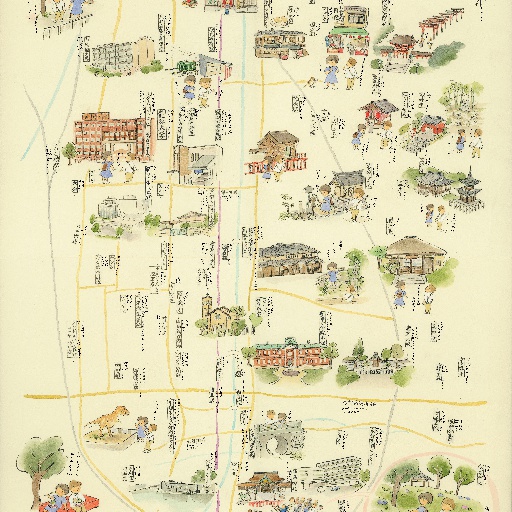
Students from Ryukoku University, located near Ryukoku-Daimae-Fukakusa Station, have researched and are introducing highlights of the surrounding area, which also includes the famous Fushimi Inari Taisha. There are also restaurants popular among Ryukoku University students for lunch, so be sure to visit the area at least once.
 Posted by龍谷大学Updated:
Posted by龍谷大学Updated: All spots information
23 spots
 京都と地蔵盆の深いつながり
京都と地蔵盆の深いつながり
京都と地蔵盆の深いつながり
![]() 京都と地蔵盆の深いつながり
京都と地蔵盆の深いつながり

京都と地蔵盆の深いつながり 昔、子どもたちが楽しみにしていた地域のお祭りとして、「どんと焼き」と「地蔵盆」がありました。「どんと焼き」とは、小正月の火祭りのことで正月飾りやお守り、お札を燃やす伝統行事で、「地蔵盆」は8月後半に町内で数珠廻しと呼ばれる直径2~3メートルの大きな数珠を囲んで座り、大人もその輪に加わりながら僧侶の読経に合わせ順々に回す伝統行事やお菓子の配布など様々な行事を盛り込んだお祭りのことです。「どんと焼き」は伏見ではほとんど見なくなっていますが、「地蔵盆」は今も京の夏の風物詩となっていて、京都市内とその周辺では毎年開催されていて、その割合は京都市全体の約8割にもなります。 「地蔵盆」の開催日 「地蔵盆」は地蔵菩薩の縁日(旧暦7月24日、もしくは、新暦8月24日)の前日を中心に行われ、最近では、参加する人たちの都合に合わせ、その前後の土日に行うところが多くなっています。また、天道大日如来を祀っている町内では、大日如来の縁日(旧暦7月28日、もしくは、新暦8月28日) を中心に「大日盆」を行うところもありますが、それらも「地蔵盆」として行うところが多くなっています。「地蔵盆」の起こりとしては江戸時代初期が有力です。 そもそもお地蔵様とは? お地蔵様は、釈迦入滅後、釈迦の次に仏陀となることが約束された弥勒菩薩が出現するまでの56億年有余年の空白期を埋めるために遣わされた菩薩です。お地蔵様は、生きている者たちがその行為や意志のよって転生する6つの世界六道(地獄、餓鬼、畜生、修羅、人間、天上)のすべての生物を救済し、福利を与えるものとされます。お地蔵様はふつう、宝珠と錫杖をもち、袈裟をまとい、頭を丸めた比丘の姿をしています。お地蔵様は、日本では、日本古来の道祖神(さえのかみ、さいのかみ)信仰と結びつきました。さえのかみとは日本神話から発し、邪霊の侵入を防ぐ神とされており、そのことから、さえのかみを道の悪霊を防いで道行く人を災難から守る神、すなわち道祖神として進行するようになりました。そしてお地蔵様は冥界と現世との境で邪悪な霊魂を払う存在とされることから、さえのかみと融合して、集落の入り口、村や町の境に、石地蔵をまつるようになりました。また、子供も埋葬されることから、子供を守るお地蔵様の信仰が生まれたので、子供のための仏としての性格も持っていました。 復活する「地蔵盆」 明治の伏見は、市街の大半を消失するという壊滅的な打撃を受け、形式的な首都の地位も失いました。この状態を回避するために街の人々は近代化への努力を続け、酒造業が栄えた新たな伏見へと脱皮を果たすことができました。このころの伏見の人々の神聖の意気盛んな時に京都の都人としての誇りが「地蔵盆」復活の原動力になったのだと言われていて、この時代に「地蔵盆」も復活を果たしたのだと考えられています。 第二次世界大戦下でも地蔵盆存続の危機にあいましたが、平和が戻ってくると復活し、以前よりも盛んに地蔵盆が行なわれました。これは、町の人々の平和を願うエネルギーが注がれた結果であると言えます。 地蔵盆と伏見は切っても切れない関係でつながれており、地蔵盆に平和を願うエネルギーははかりしえないものだと感じました。ネット社会の今、このような団結力はとても重宝すべきものであると考えます。参考文献・「子育ての町・伏見 酒造と地蔵盆」著伏見の町づくりをかんがえる研究会、子供の生活空間研究グループ 発行所 都市文化社 発効日1987年11月1日・京都をつなぐ無形文化遺産 京の「地蔵盆」-行事内容などーhttps://kyo-tsunagu.net/jizo/kyonojizobon/ 最終確認日2021年2月21日
 ランチ
ランチ
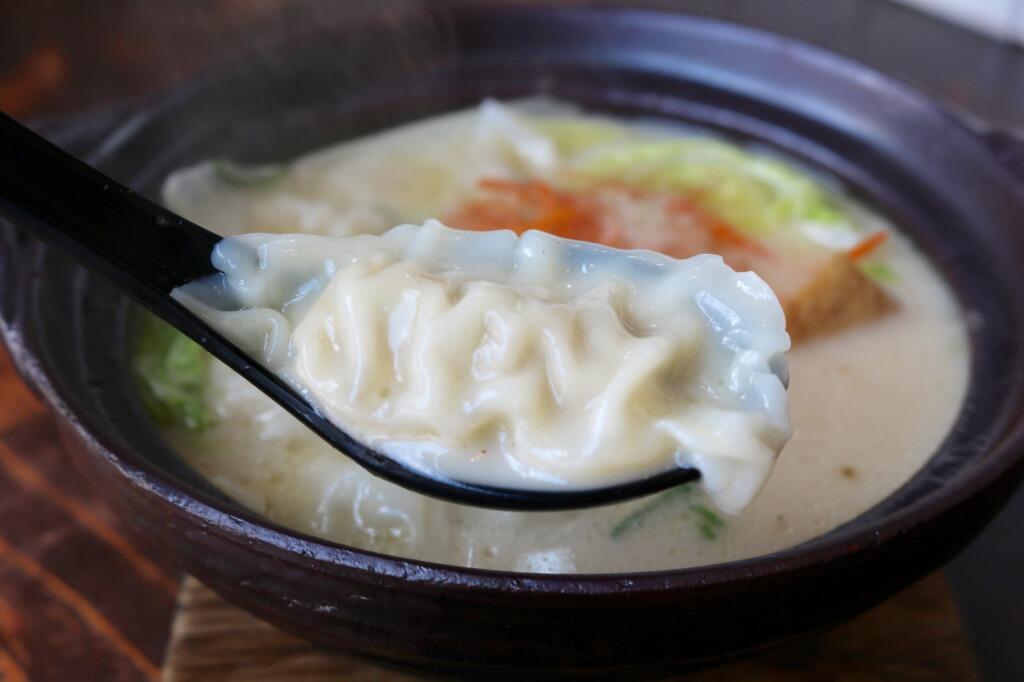
“Fukuyoshi” is a restaurant in Fukakusa area that specializes in gyoza dishes. You can enjoy many different kinds of gyoza, with stuffing and wrapping type of your choice. With its rich variety of gyoza on offer, “Fukuyoshi” is a must-go place for gyoza enthusiasts. Located on Shidan-Kaido Street, “Fukuyoshi” is very easy to access. This is yaki-gyoza (grilled gyoza) with shrimp stuffing wrapped in a thin skin (380 yen per serving). The skin is crispy, and the stuffing is juicy. I believe this is the familiar taste that Japanese love. This is “yaki-gyoza” (grilled gyoza) with pork stuffing wrapped in thick skin (340 yen per serving). Wrapped with a thick and chewy skin, just like dumplings in China, the juice from the stuffing does not escape until you take your first bite. Sui-gyoza (boiled gyoza) are also wrapped with thick skins. You can choose from stuffings of pork, celery, leek, bell pepper, and shrimp. But I definitely recommend a set of 5 pieces with a different stuffing for each (480 yen per serving), so you can enjoy five different flavors. This is the specialty of “Fukuyoshi”, taki-gyoza (stewed gyoza, 780 yen per serving). Thin-skinned gyoza with pork stuffing and shrimp stuffing, three pieces of each, are added to a white chicken broth which has been cooked for three hours in a pressure cooker. Well-soaked in the flavorful chicken soup, the gyoza taste superb. I’m quite sure that this soup goes well with ramen noodles, too. There are a lot more menu items offered at “Fukuyoshi”, including age-gyoza (fried gyoza) and negi-shio gyoza (served with salted spring onion sauce). Set meals with gyoza are also available for 590 yen per serving.
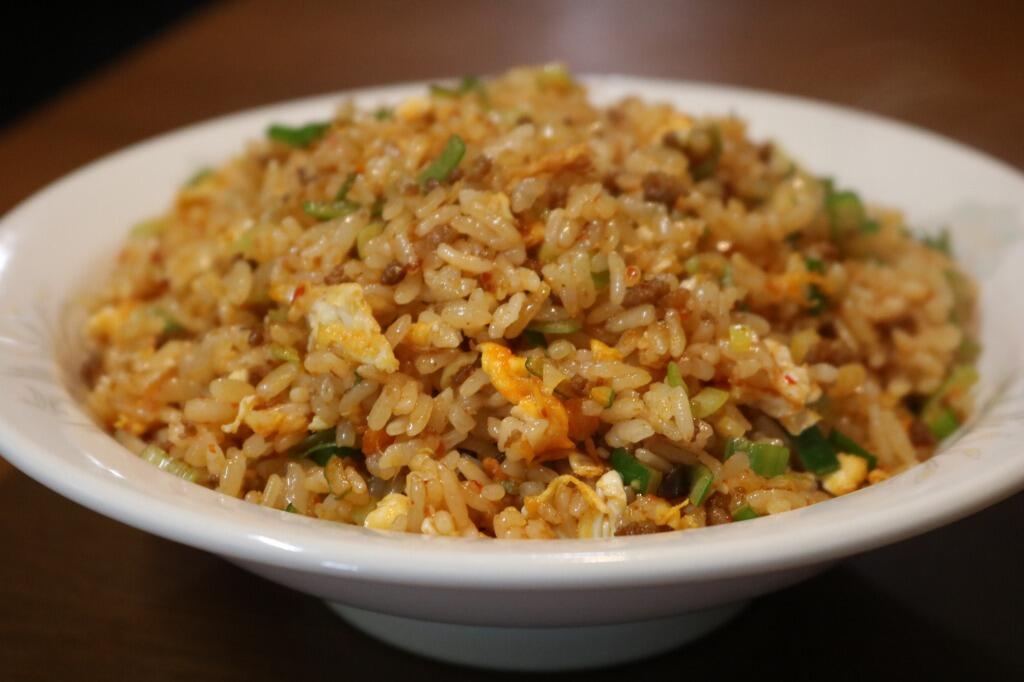
There are a lot of Chinese restaurants that has a name including “Ho” in it. They all inherits the taste of a now-closed Chinese restaurant “Homai”. Mr. Kakichi Ko, the owner of “Homai”, is said to be the founder of the Kyoto-style Chinese cuisine. If you are interested, you can know the details in the book “Kyoto no Chuka (Chinese Cuisine in Kyoto)” written by Mr. Kang Sang-jung. “Horin” is one of the restaurants preserving the “Homai” taste. If you see a banner that says “The Homai taste, faithfully recreated”, you will not be able to resist entering the restaurant. Inside “Horin” is spacious, so a large group can be accommodated. A popular “Horin” menu item is this “leek egg-roll” (1000 yen per serving). This has the typical appearance of the Chinese egg-roll served at restaurants in Kyoto. This egg-roll has a distinctive crispy outer wrap, bursting with bamboo shoots. This is “tantan fried rice” (750 yen), which is generally a very rare menu item. This fried rice is named after “tantan noodles”, a Sichuan dish of noodles covered with a chili sauce. You can enjoy the crunchy texture of chopped spring onion and a spicy hot flavor. If you want to try Kyoto-style Chinese cuisine in Fukakusa area, you should make a point of visiting “Horin”.
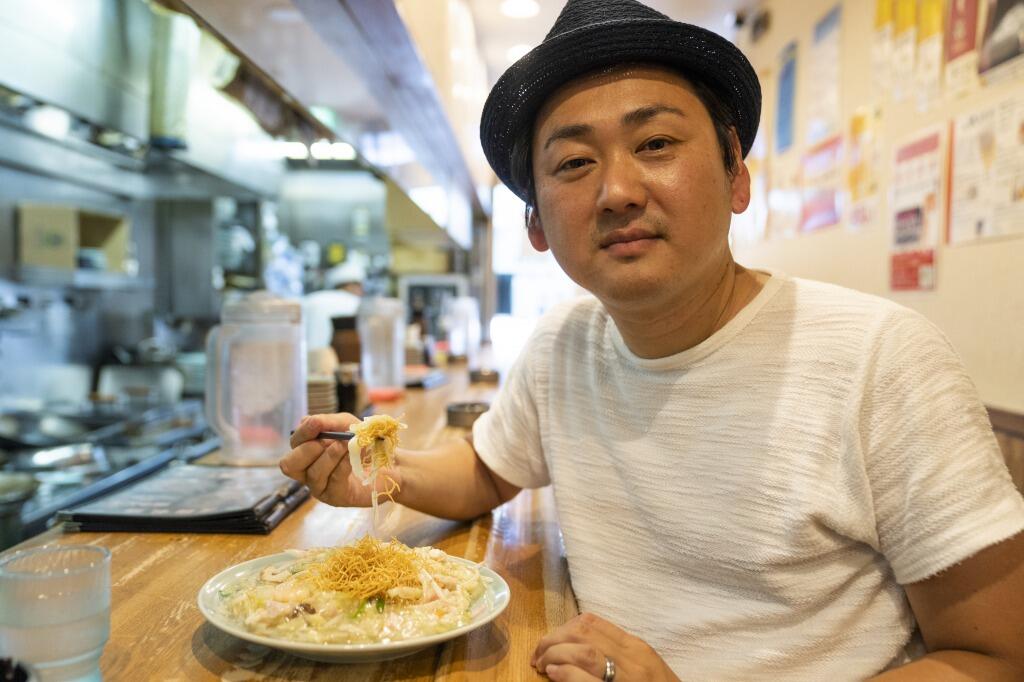
A quality Chinese restaurant beloved for a long time in Fukakusa area. Its most popular item on the menu is sara-udon (fried udon noodles with various toppings), though other menu items are all exquisite as well. “Saikai” is open until late at night, and popular both day and night. The old-fashioned restaurant is quite a comfortable place to visit. It is enjoyable to see the chef deftly shaking the pan to stir the ingredients together. It is also nice, especially for an impatient person like me, that they prepare and serve the food very quickly. The look of “Saikai” is a substantial presence on Shidan-Kaido Street. The most popular menu item is sara-udon (700 yen). The toppings are: shrimp, octopus, cabbage, chikuwa (sausage made from fish), pork, spring onion, and so on. It includes a lot of vegetables, so it is actually a well-balanced dish. The noodles are crispy, and the soup is thick and starchy, which means you can enjoy two contrasting textures. The crunchy bean sprouts add accent to the textures. The noodles soften, their taste changing as the minutes pass, and this is also good. This is a popular menu item for students, “niku-don” (a bowl of rice with pork toppings, 730 yen). The portion is large! As for donburi (a bowl of rice with a choice of toppings) in Chinese cuisine, “Teri-don” served at the Chinese restaurant “Taiho” near JR Nijo Station is the most famous. However, you just cannot miss “niku-don” at “Saikai” too! What most impressive about this menu is the volume of pork and onion in the topping. Onion is sweet, but not obstructing the flavor of the pork. Mixed with a salty-sweet sauce, the topping has a really rich flavor. It all matches perfectly with the white rice that comes with this dish. You will find yourself compulsively requesting another helping of the rice, over and over. I had lunch at “Saikai” after a long absence, but I’m sure that you will be satisfied whichever menu item you select.
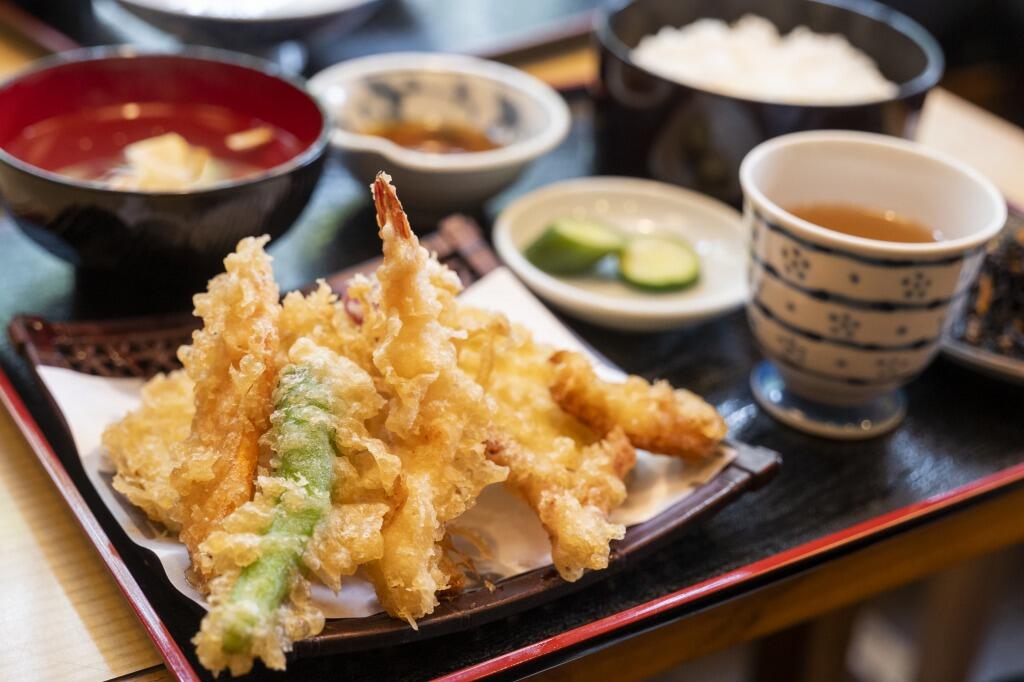
In Nishiura-cho, the area right in front of the Fukakusa Campus, there are several famous restaurants that have been favored by students for a long time. Among them, “Tempura Ten-ei” is the must-go-to restaurant. If you want to have tempura in this area, you should go to “Ten-ei” At lunchtime, you can have one of each item from the entire menu for 800 yen, with tax included. What a simple way to charge! Not only is the price is reasonable, but the restaurant offers a rich variety, including set meals with tempura or fried prawns, grilled fish, or sashimi, as well as donburi (a bowl of rice with a choice of toppings) with tempura, or with tuna cutlets, and so on. And the menu is not just reasonably priced, just look at how generous this set meal is with tempura! It is served with some side dishes and a cup of soup. A regular-sized rice portion at this restaurant is almost the same size as a normal large-sized rice portion. Tempura donburi is also served with a variety of tempura on it. Prawn, pumpkin, onion, and seaweed… Delicately cooked, with lightly crispy, crunchy texture. I enjoyed tempura at “Ten-ei” after a long absence. If I get used to this price, I will not be able to tolerate the lunch I usually eat near my office any more.
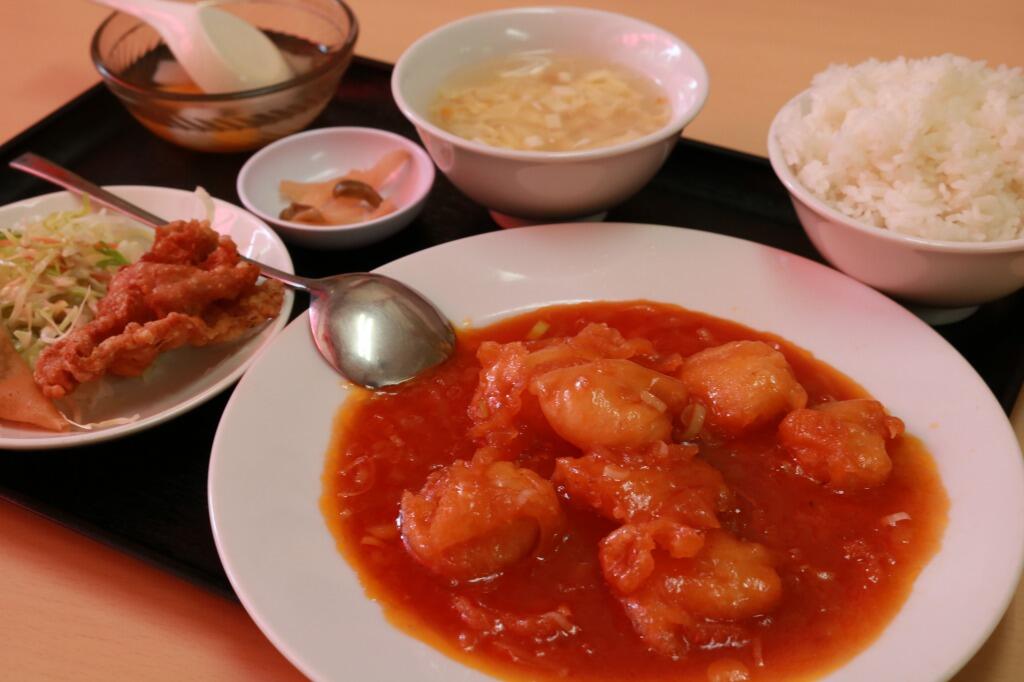
“Shinka” is located on the east side of Ryukoku University, on the street toward Fukakusa Station on the Keihan Railway line. The owner is from Shandong Province, China, so you can sample authentic Chinese cuisine. Among a variety of menu items, I recommend you have gyoza (dumpling) wrapped with their homemade skins. As the owner is from China, the interior of the restaurant is decorated in Chinese style. There are two styles of Chinese diners in Kyoto: Ones decorated in authentic Chinese style, and the others decorated in Kyoto style for Japanese customers. People in Kyoto find their favorites according to their preferences, or decide which one to go just depending on their feelings on the day. “Shinka” offers two types of gyoza. The one in the photo is sui-gyoza (boiled gyoza) with fennel. (500 yen for 6 pieces). The homemade gyoza skins are soft and easy to bite into, and richly flavored too. Can you see juicy meat stuffed in the skin? This is so tasty! Be sure to note that the other type, yaki-gyoza (grilled gyoza), is served only in the evenings. A rich variety of set meals (850 yen per serving) are available during lunchtimes. My recommendation is the set meal with stir-fried shrimp in chili sauce. There is a generous serving of shrimps in the dish, and the set meal is served with fried chicken and dessert. It really is a huge meal. I might add that plump shrimp fried in chili sauce matches perfectly with white rice. You can also have set meals with noodles or donburi. Please try many different menu items if you can.
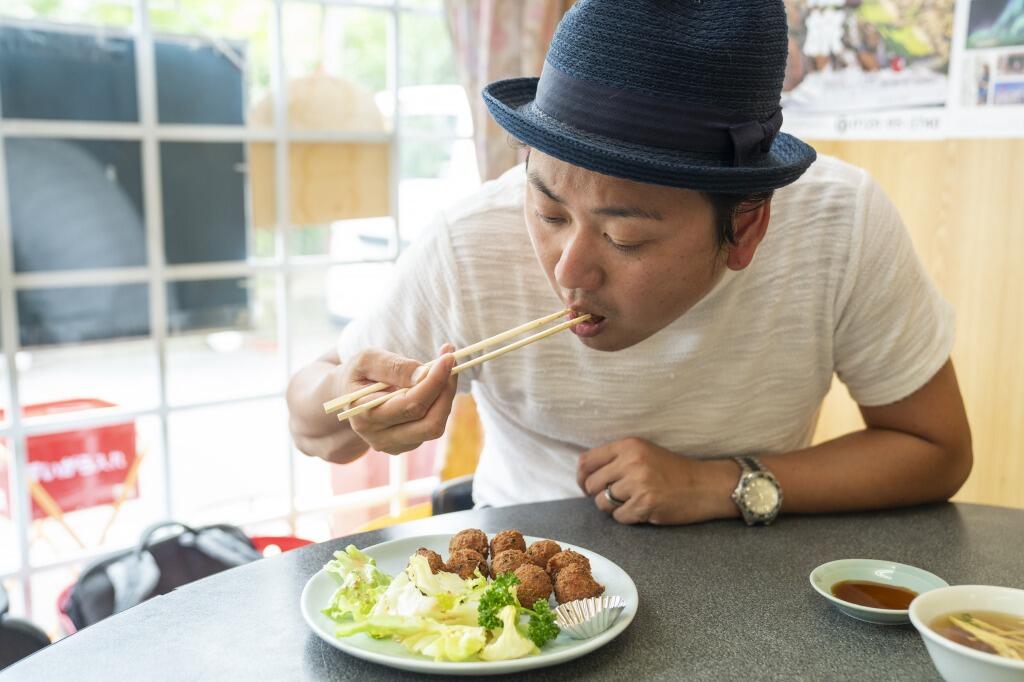
“Meiyoken” is a Chinese restaurant in Fukakusa. Here, you can dine in a homely atmosphere and take in the rich variety of noodles on offer, such as ramen, wonton noodles, and fired noodles, as well as a-la-carte dishes. Daily special lunch (780 yen per serving) is a popular menu item for regular customers. This is “mini-sized fried rice” (500 yen per serving). Although it is “mini-sized”, it is actually quite a generous helping. This rice is not sticky, and it is cooked with a lot of eggs. The soup comes with it as a set, and this is tasty too. Fried meatballs (800 yen per serving) is the menu item that is rarely offered at other restaurants. Being fried, the outer layer of the meatballs becomes crispy. Just putting salt and pepper is enough. They match with the white rice, as well as going well with alcohol. 7 pieces of gyoza are served per dish. 280 yen per serving is quite reasonable. Restaurants in Kyoto usually serves 6 or 7 pieces of gyoza per dish, and I can’t help happily counting them when I receive my gyoza order. The skin of the gyoza is not too thick, so you can enjoy the taste of the fillings more directly. “Meiyoken” prepares foods to suit the Japanese palate, and you will never tire of the flavors they create.
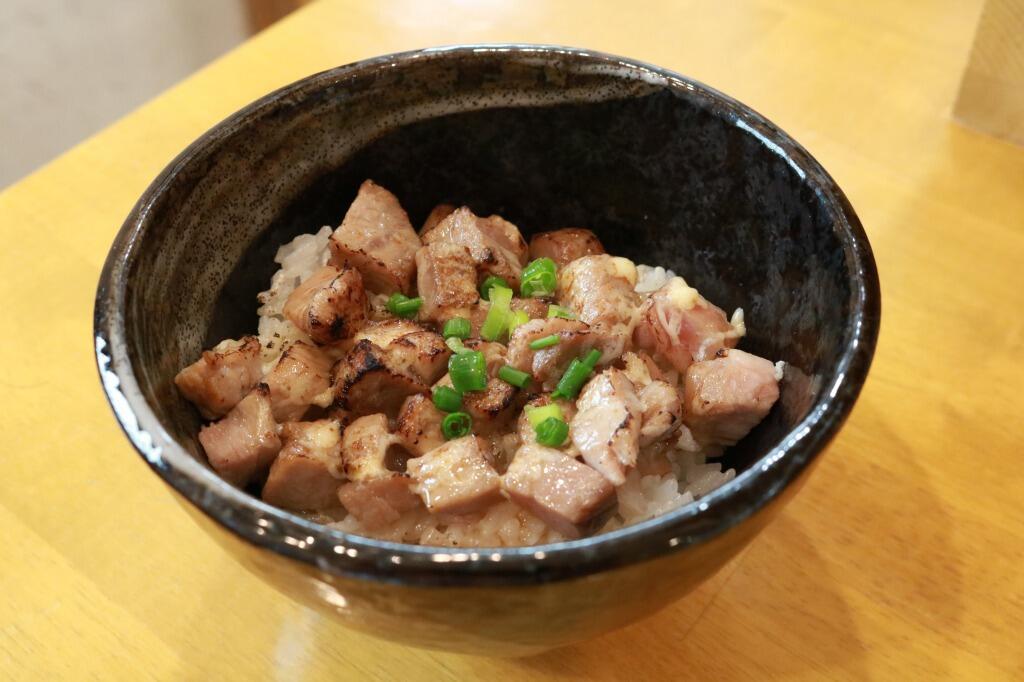
There are a lot of new ramen shops opened one after another in the past few years around the Fukakusa Campus of Ryukoku University. The area is now referred to as a ramen battleground in Kyoto, along with the famous Ichijoji area, and have gotten a lot of attention from ramen experts in Kyoto. “Ramen Miyabi” is one of the most popular shops in this battleground. “Ramen Miyabi” is located in Nishiura-cho, the area right in front of the Fukakusa Campus. Lots of students live in apartments in this area. I also had friends living in this area, and often visited and stayed with them for no particular purpose. The greatest feature of the ramen at this shop is this light fluffy soup. This is the soup used for the “Tori-ton Ramen” (salty soup or soy-sauce soup, 700 yen per serving). Ramen noodles are covered almost entirely by the Cappuccino-like smooth, densely-frothed soup. It tastes mild and mellow. The flavor of chicken (tori) and pork (ton) comes out gradually but clearly. As for me, I just can’t stop my addiction to it! The smooth and slightly chewy and sticky ramen noodles come from made-in-Japan wheat. The noodles match perfectly with the soup. I can declare that this soup and these noodles were meant to be together. “Buta-meshi” (rice with roasted pork, 250 yen). The smell of barbecued pork stimulates our appetites. It costs less than 1000 yen even if you have “Buta-meshi” with ramen. How reasonable is that? It usually costs 100 yen for an extra-large helping of noodles, but it’s free for students. I want to be a student again…
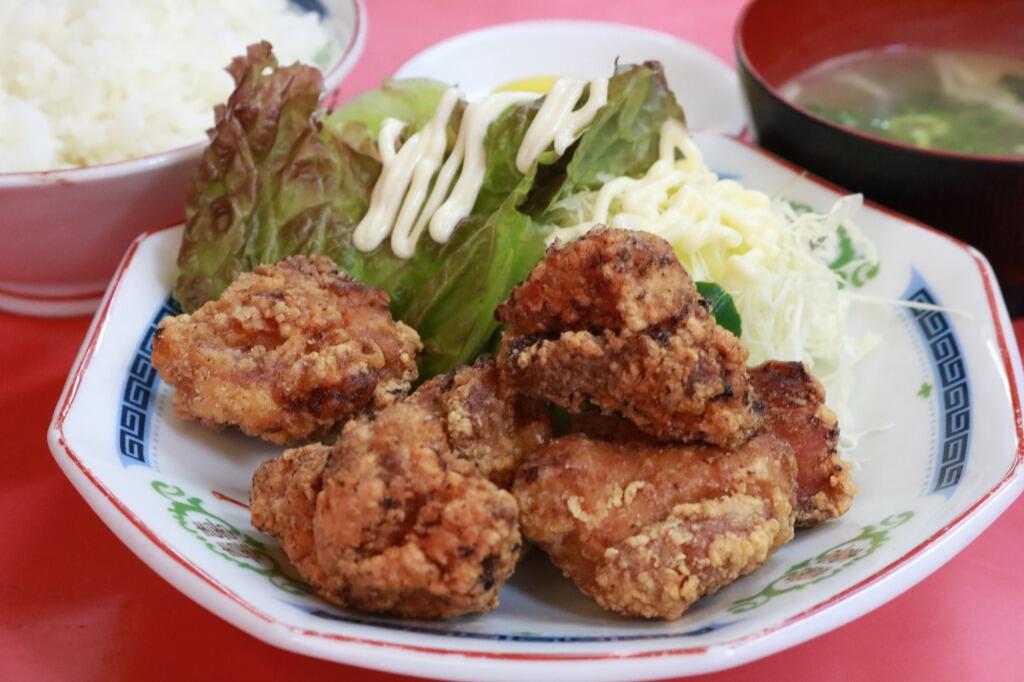
“Ramen Kiraku” is an old ramen shop located right on the west side of the Fukakusa Campus. They offer a variety of set meals in addition to ramen. It resembles a normal diner or small Chinese restaurant rather than a ramen shop only. How long has it been since I came here last time? I’m quite sure that there are no Ryukoku alumni who have never eaten at this shop while in school. The owner and his wife are kind, friendly and cheerful just as I remember. It might come as surprise that this is a favorite ramen shop of a very famous singer from Kyoto. There are her CDs and autographs displayed, crowded together on one wall. Many of her fans also visit the shop from all over Japan, as if on a pilgrimage to a holy place. You can see how “Ramen Kiraku” is fondly loved by many people, including local residents and students of Ryukoku University. Its ramen menu is rich in variety. There are so many choices that you cannot easily decide what to have. Personally, I recommend the “Curry ramen” (ramen with curry soup, 720 yen per serving). The ramen soup, made using rich stock, makes the curry more tasty. It is best to have this after enduring some of hot summer weather. Fried rice (530 yen) is another must-have menu item. Because it is stirred well while being fried, this rice is not sticky. Here is the specialty of this shop, a set meal with fried chicken (700 yen). Well soaked with their homemade salty-sweet sauce, you can enjoy juicy chicken with the taste of the sauce in every bite. It matches perfectly with white rice, which you will find yourself compulsively requesting for another helping, over and over. Another popular menu “Hanchan” is a set consisting of a bowl of ramen and a half-sized portion of fried rice, for only 680 yen! You can see why this is popular among students, can’t you? There were a lot of students in the shop when I visited, and watching students and the owner chatting, I realized that everyone loves the food here not only because it is delicious but also because the owners’ love for food and the company of their customers is reflected in the food they prepares for them.
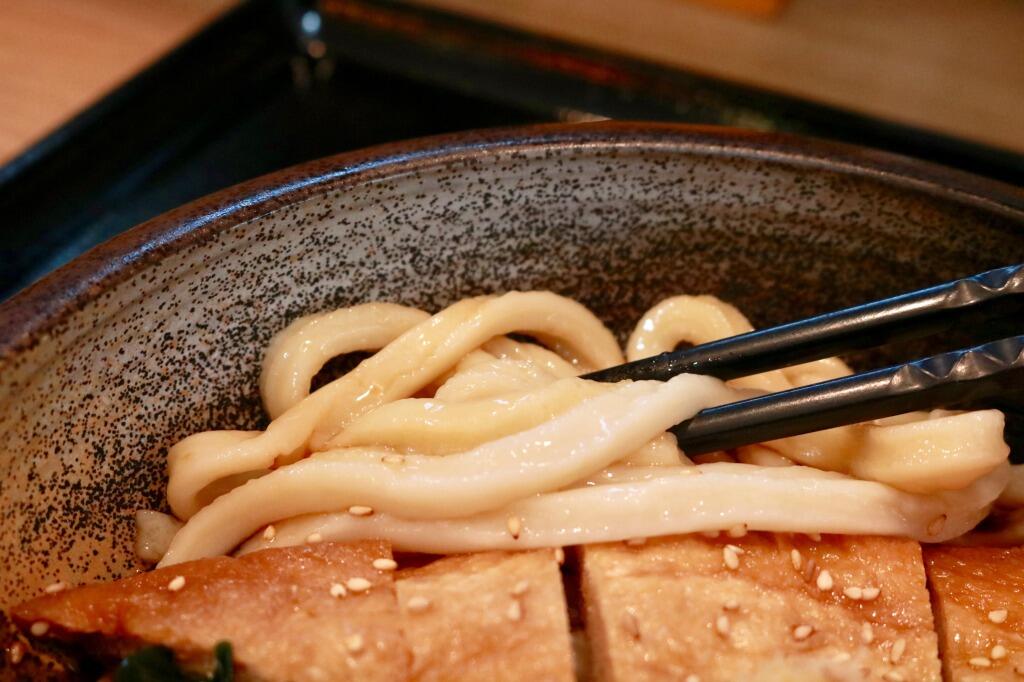
Udon and soba noodles are very simple foods. A chef’s elaborate efforts should not be overtly displayed in it. They appear easy to cook, but actually they are sophisticated cuisine using intricate recipes. If you want to enjoy udon noodles in Fukakusa, you should go to “Kendonya.” Located close to Fushimi-Inari Station on the Keihan Railway line, a place crowded with many tourists visiting major sightseeing spots nearby, this udon eatery is popular for its hand-kneaded noodles, often introduced on TV and in magazines. They have an English menu, as a lot of foreign tourists have been visiting the premises recently. “Hiyashi Kitsune” (udon noodles with deep-fried tofu served in cold soup, 820 yen) is a perfect menu item for a hot summer day. The thick udon noodles are smooth and easy to bite through. When served in cold soup, you can enjoy the al dente texture even more. It has a number of toppings, such as sweet fried-tofu, seaweed, chopped green onion, and thin omelette cut into strips. A slight sesame flavor adds a pleasant accent to it. “Kendonya” also offers a variety of set meals consisting of udon noodles with donburi (a bowl of rice with a choice of toppings).
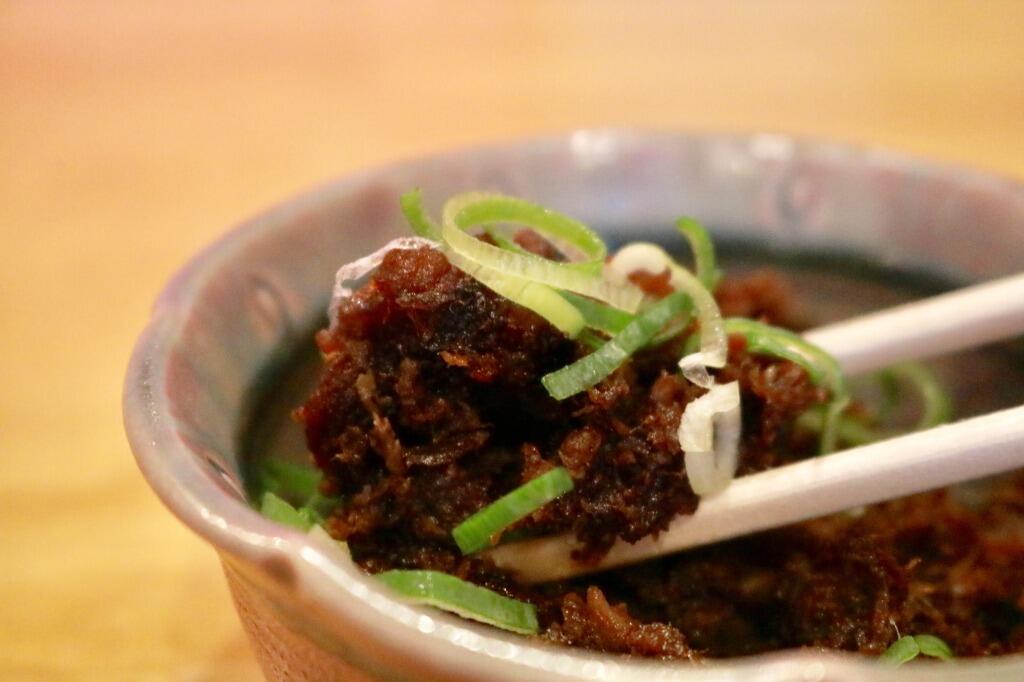
In my personal opinion, quality of lunch at izakaya (Japanese-style pubs) greatly differs from one pub to another. Izakaya are open mainly in the evenings. So, some of them open at lunch time just as side businesses, or some even offer lunch just to finish off left-over food from the previous evening. These izakaya do not offer good lunches, unfortunately. However, there indeed are some izakaya that provide excellent lunches, committed to make them equal in quality to their evening offerings. If you eat lunch at one of these places, you will definitely become interested in having dinner there as well. As a result, the izakaya will be popular for both lunches and dinner times. This is a typical example of winning admiration if you work hard at everything, without cutting corners. There is one such wonderful izakaya in Fukakusa: “Renge”, an izakaya that gives their best for both lunch and dinner. Looking around the spacious pub, you can find a good many paper sheets posted on the walls, with a tempting menu selection written on each. The specialty of this izakaya is “Chiritori Nabe”, a hot pot in which beef or pork offal with plump texture are cooked with a lot of vegetables. They also offer staple menu items such as dashimaki (Japanese omelette), katsutoji (pork cutlet with simmered eggs), and stewed beef tendon, in addition to a variety of set meals. Their fried chicken is especially popular, and you can take it home not just eating it at the pub. “Toripon Teishku” (set meal with fried chicken, 880 yen per serving) is an ever-popular lunch menu. See how huge each cut of the chicken, and how generously they are served! Juicy chicken in crispy fried batter. Everyone loves it! Stewed beef tendon is a popular dinner menu item. Stewed well for a day, the tendons are very rich in flavor. You can also select it as a side dish of a set meal. If you are a university student, you can have a glass of highball for 200 yen, which usually costs 400 yen. This student-friendly izakaya is loved by many people, for both lunch time and dinner time.
 紹介
紹介

藤森神社 名水「不二の水」が湧き出す創祀1800年の歴史ある神社 5月5日の駈馬神事は必見! みなさんは願掛けをしたことはありますか?願掛けといえば神社にお参りに行って神様に祈りを捧げることです。学生であれば受験の前などに一度はしたことがあるのではないでしょうか。藤森神社は、勝運と学問の神様に加えて馬の神様が祀られています。馬の神様が祀られているだけあって騎手の武豊さんなど、競馬関係の方が参拝に来られるみたいです。そんな藤森神社ですがどのような経緯で創設され、人々に親しまれるようになったのでしょうか。 そんな藤森神社ですがどのような経緯で創設され、人々に親しまれるようになったのでしょうか。 藤森神社の歴史 藤森神社は2005年に創祀1800年を迎えた歴史ある神社です。神社に伝わる縁起によると藤森神社の起源は、神功皇后が新羅征伐を成し遂げた後、全ての兵具を納め、塚をお造りになり、「弓矢蟇目(ゆみやひきめ)の法」を修して神々を祀り始めたことだとされています。 平安時代から、現在の藤森神社の周辺は藤の林で盛り上がっており、神社の神紋が「登り藤」であることから、藤の林と関連があることが分かります。 むらさきの 雲とそよそに みえつるは 木高き藤の 森にそ有ける 小侍院 このように小侍院の和歌にも詠まれ、この辺りの地域が「藤ノ森」と呼ばれるようになったと推測されます。神社も、「藤ノ森にある神社」ということから「藤森神社」と呼ばれるようになったとか。 藤森祭について 毎年5月5日に行われ、菖蒲(あやめ)の節句発祥の祭りとして知られています。節句に飾る武者人形には「藤森の神」が宿ると言われており、今でも祭りの日に伏見街道の旧家では甲冑を飾り、通る人々に披露しているそうです。菖蒲の節句に因み、武事・軍事を尊ぶ祭りとも考えられ戦勝・武功を祈願する神様とされてきました。 藤森祭では二つの催しがあります。次に、その催しについて触れていきたいと思います。 ・駈馬神事 1200年の歴史を持つ伝統行事である駈馬神事(かけうましんじ)で、馬に乗りながら筆で文字を書く「一字書き」であったり、馬の上で逆立ちしたりするなど、駆け抜ける馬上での様々な曲芸を披露しています。観客は、目の前で繰り広げられる盛大な曲芸に目を奪われ、大きな歓声を起こします。駈馬神事は藤森祭を賑わす一番の催しと言っても良いでしょう。 ・武者行列 武者行列には四つの行列があります。「朝渡」と呼ばれる御祭神早良親王の東征の行装、「皇馬」と呼ばれる清和天皇勅諚による深草貞観の祭りの行装、「拂殿」と呼ばれる御祭神神功皇后凱旋・旗神祀の行装と「七福神」の行装で、これらの先頭に鼓笛隊が進む形で氏子地域を練り歩きます。 地域の人々に愛される不二の水 京都の飲める名水で、日本を代表する酒どころである伏見の名水です。 不二の水の「不二(ふじ)」は二つとないおいしさという意味で、「藤(ふじ)」とかけた名前になっています。「不二」は「不死」にもつながり、健康長寿、勝運にもご利益があると言われています。地元の方々がペットボトルに水を汲みに来る姿が見られます。不二の水は地域の人々に愛されている名水であることが分かります。 石川五右衛門が寄進した台石の秘密 石川五右衛門と手水鉢台石 神社に行くと必ずある手水鉢ですが、藤森神社の手水鉢にはある言い伝えがあります。それは、天下の大泥棒である石川五右衛門が、盗んできた石を台石として使っているのです。ただの台石では言い伝えとして残るはずがありません。では、どこから盗んできたものなのでしょうか。実は、石川五右衛門が盗んできた台石は、宇治市の浮島にある十三重石塔の上から5番目の石を盗んできたと言われています。では、何故わざわざ盗んできて藤森神社に寄進したのでしょうか。 五右衛門は豊臣政権五奉行の一人である前田玄以に追われ、その時に逃げ込んだのが藤森神社でした。前田玄以は、神社に対し身柄の引き渡しを求めましたが、神社側が「管轄が違う」という理由で引き渡しを拒否しました。この神社の対応によって逃亡に成功した五右衛門は、その御礼として宇治の浮島にある十三重石塔から石を盗み藤森神社に寄進したそうです。参考文献・石川五右衛門が盗んできた藤森神社の手水鉢台石https://kyotohotelsearch.com/blog/2011/11/07/fujinomorijinjachozubachi/最終確認日:2021年2月21日・LINE トラベルjp 藤森神社の不二の水https://www.travel.co.jp/guide/article/20112/最終確認日:2021年2月21日・Japan’s Travel Manual-for your pleasant journeyhttps://jpmanual.com/fujinomorijinja最終確認日:2021年2月21日・ラジオNIKKEIhttp://www.radionikkei.jp/kodanwalk/sp/post_31.html最終確認日:2021年2月22日・深草を語る会『深草を語る』財団法人 深草記念会(2013)p58〜63
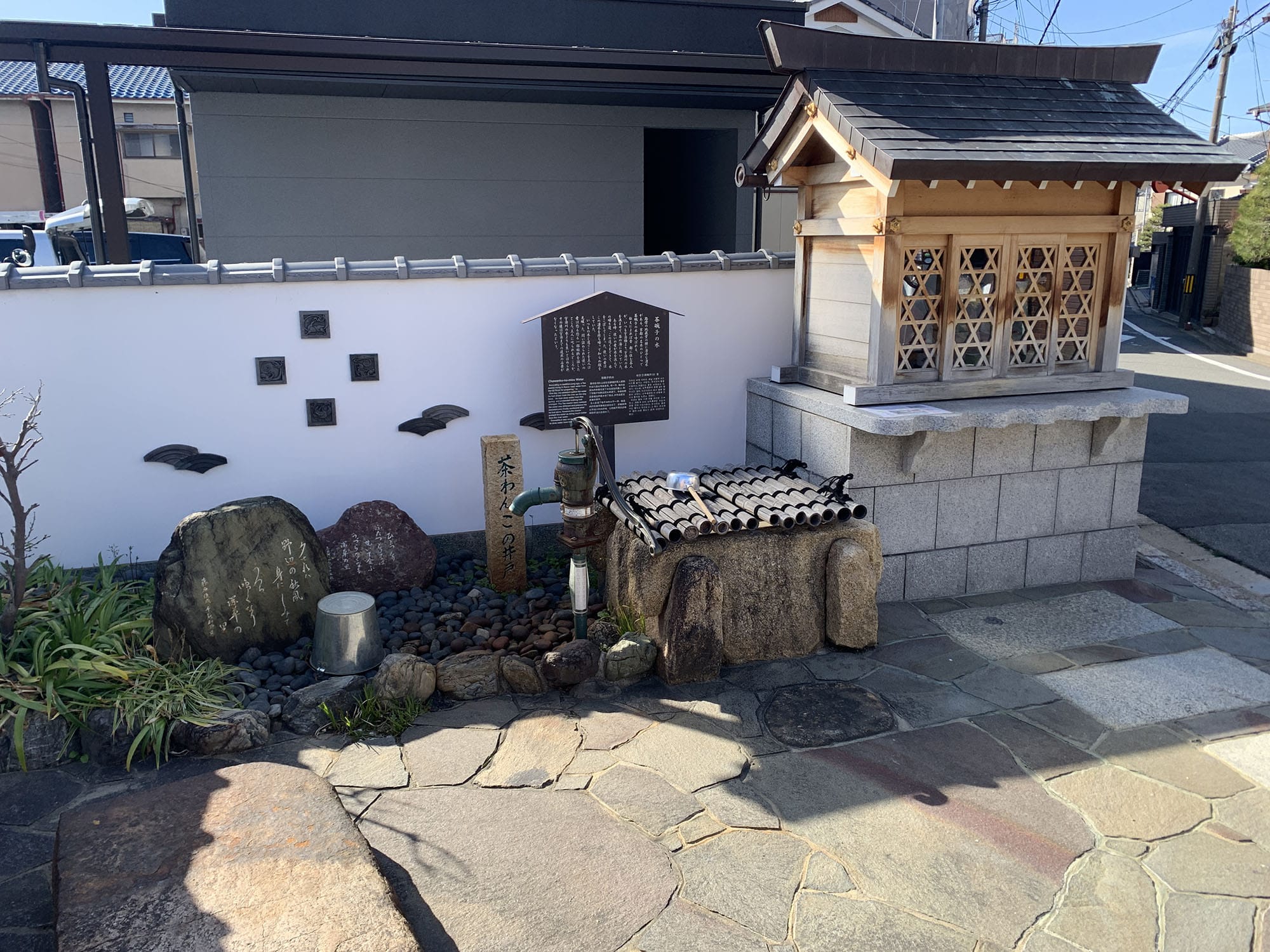
伏見街道を行く② 小さな博物館のような茶碗子の井 伏見街道(本町通)から石峰寺の方に歩いて行くとその井戸はあります。井戸の名は、「茶碗子の井」。古くから地域の人に利用され、町の人によって魅力あふれるスポットへと変貌を遂げた、茶碗子の井について探っていきます 伏見街道(本町通)から石峰寺に向かう途中、石峰寺の石段下から南西方向の道路脇に小さな地蔵堂と「茶碗子の井」と呼ばれる井戸があります。この井戸から湧き出る水は「茶碗子の水」と呼ばれる京都の名水の一つです。 地元では「清水」と呼ばれており、近所の農家が野菜を洗う共同水場となっています。また、明治の初めの頃までは、100mほど西を通る伏見街道までこれらの井戸一つから木菅が引かれ、街道に面した一本松のあたりを往来する人や、牛馬の飲み水として利用されていたと伝えられています。しかし、残念ながら現在水は湧き出るものの飲用水ではありません。 まるで小さな博物館?京都 深草の歴史・文化にあふれる装飾 2014年6月町内や地域の方々によって井戸の周辺が整備されました。井戸の横にある地蔵堂には四体のお地蔵さまがおられます。地蔵堂は、堂の中には町内出身の日本画家作の広大な宇宙と恵みを与える太陽、水豊かな地球を描いた内壁画が描かれており、洗い場の野菜かごをイメージしたかごめ格子戸が取り付けられています。波形の台石は流水をイメージされており午前中には波形の影を見ることができます。 井戸には石組みの井筒竹蓋がされており、開けると清水が見えるようになっています。さらに、手動揚水ポンプが設置されているので、手押しで井戸水をくみ上げることが可能です。 井戸周辺には様々な装飾が施されています。京の都を守る四神を描いた装飾京瓦、平安時代に深草を詠んだ藤原俊成の歌碑(町内会員の揮毫)など、細部までこだわられた装飾がされています。この装飾は京都・深草の文化をギュッと集めたようになっているので、是非現地に足を運んで見て欲しいスポットです。私は実際に見た時、小さな博物館に訪れたような気持ちになりました。 「茶碗子の井」にまつわる昔話 「茶碗子の井」には、名前にちなむ話が語り継がれています。 昔、都に住む茶人が茶を点てるにあたり、使いの者に宇治橋三の間まで水を汲ませていました。しかし、ある日使いの者が水を汲んで持ち帰る途中にこぼしてしまいました。そこで仕方なく、石峰寺の横の井戸で水を汲んで持ち帰ったのですが、叱られることを恐れてこぼしてしまった事実を隠していました。茶人はいつもと違う水に気づくとともに、この水の方がおいしいと褒め、以後この茶碗子の水で茶を点てるようになったそうです。参考文献・深草を語る会『深草を語る』財団法人 深草記念会(2013年)P22・23・『京都観光オフィシャルサイト 京都観光Navihttps://ja.kyoto.travel/tourism/single02.php?category_id=9&tourism_id=41 最終閲覧日:2021年2月27日
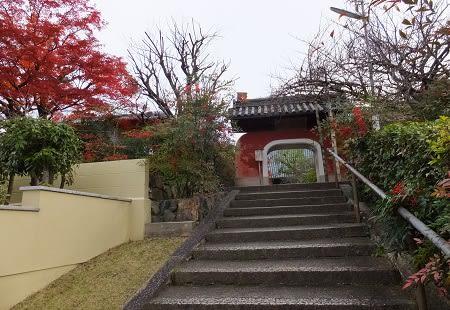
Let’s take a close look at Sekihō-ji, a temple with deep ties the celebrated painter Itō Jakuchū. The art of Itō Jakuchū, the Edo Period painter whose influence on Japanese art was enormous, has been applauded within Japan and around the world. It’s said that Jakuchū lived in a small hut in front of the gates of this temple. In this report I will investigate the relationship between the artist and the temple which took him in after he lost his home in the great fires that ravaged Kyoto in 1788. The Hyakujō-zan Sekihō-ji temple, as it is officially named, belongs to the Ōbaku-shū, one of the three great sects of Zen Buddhism. It is located in the Fukakusa neighborhood of Kyoto, within a kilometer from Ryūkoku University’s Fukakusa Campus. From the entrance to the temple one is afforded an expansive view of the entire surrounding area. There is a straight flight of stone steps leading to a sanmon gate built in the Ming style. The deep vermillion hue of the gate melts into the surrounding garden, imparting on the visitor a feeling of great tranquility. The auspicious color of this gate is said to ward off evil, explains the temple’s abbott. Another interesting feature is that these gates do not have any doors, unlike sanmon gates of other traditional Japanese temples. The Ming-style sanmon gate Sekihō-ji was established by the monk Senai Shōan in the Hōei Era (1704~1710). At the time it was established, the temple grounds were far more expansive than they are today, reaching as far as the current-day JR Nara railway line. Jakuchū’s dwelling is said to have stood near the edge of the grounds. However, due to tides of anti-Buddhist sentiment and the expansion of agricultural land, the temple grounds shrunk in size to that of today. Ōbaku-shū Zen was brought to Japan in the early Edo Period by the poet-monk Ingen, whose influence on Japanese culture extends to the culinary field. It’s said that he was responsible for introducing several new foods to Japan, including ingen beans and watermelon. The temple itself is built in a style similar to those of the Rinzai Sect of Buddhism. The fittings in the Main Hall are designed with manji swastika patterns, as part of a wish to bring in a multitude (man meaning ‘ten thousand’) blessings. At first glance the temple does not seem to have any overt connection to the great painter Jakuchū, so what exactly was his link to the place? Itō Jakuchū was born in 1716 into a family of fruit and vegetable merchants in Kyoto’s Nishiki Market. He took over the family business at age 23, but at age 40 Jakuchū handed the reins to the business to his younger brother and set about devoting himself to his painting. In 1771, under orders of the Kyoto machi-bugyō officials of the shogunate, Kyoto’s Nishiki Market was ordered to cease trading. Jakuchū worked tirelessly to get the market reopened, gathering petitions from local farmers and mobilizing the people. Moreover, through his apprentice the abbot of Sekihō-ji, Jakuchū was granted audience with Hakujun Shōkō, chief of the Ōbaku-shū sect’s head temple Manpuku-ji. From Hakujun, Jakuchū received the Buddhist name Kakusō, as well as the head priest’s vestments. Eventually, the ban on trading at Nishiki Market was lifted, but for this to have happened one can imagine Jakuchū arguing the case for the local market, “Kyoto’s kitchen,” dressed in Buddhist garb. The official robes of Manpuku-ji bear a crest officially sanctioned by the Tokugawa shogunate, the ura-fuji. Perhaps Jakuchū flaunted this in front of the Kyoto machi-bugyō to get them to take part in negotiations. However, in 1776, Hakujun Shōkō, the head priest of Manpuku-ji to whom Jakuchū had been so indebted, passed away. Beginning the following year, Jakuchū created as many as 1000 gohyaku-rakan statues over a period of ten years to mourn the great man. As he worked on his memorial, in 1788 the Tenmei Fires took a great toll on the city, and Jakuchū lost his home. After moving from place to place, he was able to find residence in the cottage beside the Sekihō-ji temple gates. through the help of the seventh-generation abbot Mitsusa1n. It’s said that with his fortune lost to the fires, Jakuchū painted Fushimi-ningyō figures to earn a living. After Hakujun’s death, Jakuchū created almost 1000 gohyaku-rakan statues over a period of ten years to mourn his benefactor. Around 530 of these statues survive to this day. It’s said that Jakuchū, dividing the work between his acolytes, and again with the help of Mitsusan, produced the statues at a pace of one every three days. Today, these statues remain in their original state in the area behind the temple. One feature of gohyaku-rakan is that they vary not only in size and shape, but also facial expressions. It’s a pleasant pastime to search among the myriad statues for the one you like best. It’s a cool, serene spot, located in a stand of bamboo- a perfect retreat from the summer heat. From Jakuchū’s gravesite one can take in a beautiful view over the Fukakusa area, including our very own Ryūkoku University. Each year on the anniversary of Jakuchū’s death, the temple puts on display a selection of its collection of the artist’s paintings and hanging scroll artworks.

Ikaruga Koemon: the founder of Fushimi-ningyō? I wonder how many readers would be familiar with the name Ikaruga Koemon? Even amongst historians, his name is largely unknown. But according to some accounts, Ikaruga Koemon is credited as the man who started the traditional Japanese pottery craft of Fushimi-ningyō. Some other versions of history, however, claim the man was nothing more than a legend. Whichever version you subscribe to, it’s clear that Ikaruga Koemon is a figure swathed in mystery. Let’s take a closer look at some of the myths surrounding the man. The three origin stories of Ikaruga Koemon There are several theories as to Ikaruga Koemon’s origins. One version has it that he was a doll artisan with thorough local roots, born in the vicinity of Tōfuku-ji temple. Another claims he was a samurai in the service of Hayashi Gemba, vassal of Ukita Hide’ie, who after the Battle of Sekigahara settled quietly in the town Fukakusa and began a career crafting dogū clay figures.According to this version, it is believed that Koemon lived adjacent to Fushimi Inari Shrine for seven years, earning a living from his craft. Finally, a third account of his life describes Koemon as a potter from Fukakusa who was invited to work in Osaka Castle by the warlord Toyotomi Hideyoshi himself. In this version Koemon is said to have been killed during the Siege of Osaka. 2. Was Ikaruga Koemon a real person? Though some experts assert that the person Ikaruga Koemon never actually existed, others refute this claim with evidence. Shiomi Seiran, author of the book Fushimi ningyō, does not agree with the concept of Koemon as a completely fictional personage, and points to the existence of pottery bearing the potter’s name as evidence. Some posit that many of the pottery pieces bearing Koemon’s name are fakes, but it’s thought this may be because he was well-known through channels of popular culture such as plays and stories, and forgers used his name to sell their counterfeit pieces. The experts who argue that Koemon was in fact a fiction have proof of their own. With regards the theory of Koemon’s serving Toyotomi Hideyoshi and perishing in the Siege of Osaka in 1615, the Fushimi ningyō genre of pottery figures is believed to have started after this date, making Koemon’s role as the originator of the style impossible.Moreover, the proliferation of fake pottery pieces bearing the Koemon name is further evidence, some argue, that the man was a fictional personage created in later generations. Ikaruga Koemon in kabuki On March 3, 1608, Hayashi Gemba, the vassal of Ukita Hide’ie, was murdered by a person named Tōmasakuroemon because of a personal grudge. Later, at Tengachaya in Osaka, Hayashi’s sons Jūjirō and Genzaburō avenged their father’s murder with the help of their servant Ikaruga Koemon. A kabuki play based on this incident, entitled Daiganjōju Dengachaya-sō made its debut at Osaka’s Fujikawa-za theatre in December 1781. It appears that Ikaruga Koemon was famous enough to be included as a character in kabuki, which used historical and mythological stories in many of its narratives. . Ikaruga Koemon’s influence on Fushimi ningyō As is obvious from the name, Ikaruga Koemon is credited with being the originator of the Koemon style of Fushimi ningyō pottery figures. Hoever, from the Meiji Period through to the early Shōwa Period, many pieces of counterfeit pottery bearing the Koemon mark were produced. Engraved with production dates of the Taisho or Kan’ei Periods, these forgeries are impossible for the layman to distinguish, and hence the authenticity of the entire range of Koemon pottery is rather murky and unknowable. One of the forms Koemon-style pottery often takes is the god Hotei or his followers, and these figures were thought to have been popular from the Edo Period through to the Taisho Period. As one story goes, Ikaruga Koemon’s inspiration to craft pottery figures stemmed from his fascination by the Hotei statue housed in the Kaizandō Hall within the Tōfuku-ji temple complex. However, like much of this man’s life, this detail is also shrouded in mystery and the story has been dismissed as mere legend. 5. Ikaruga Koemon in the present day When looking at a piece of Fushimi-ningyō pottery, it’s fascinating to imagine that the person who gave birth to this now-common craft form was in fact a “fictitious person.” What kind of man was he? What motivated him to be a start this distinct variety? Even after researching this man, one feels that there is still more to be discovered about him. It is interesting to learn that Ikaruga Koemon was connected with aspects of history and culture such as kabuki, and the revenge attack at Tengachaya. On a personal level, I feel that the man who is said to have worked for Toyotomi Hideyoshi and later died in battle is a gallant figure deserving of respect. It is probable then, that his life and legend will continue to be discussed. Ikaruga Koemon lives on in the hearts of those who maintain the man’s legacy through passing on his story.

Why did Kiroku and Seihachi buy Fushimi-ningyō dolls in the the story Sanjikkoku Yume no Kayoi-ji? Sanjikkoku Yume no Kayoi-ji is a famous Kamigata rakugo* story, set aboard one of the sanjikkoku ferry boats that once ran between Osaka’s Hachikenya wharf and Fushimi, in the south of Kyoto. On the Fushimi Kaidō road, the story’s two main characters, Kiroku and Seihachi, buy pottery Fushimi-ningyō dolls, which were popular souvenirs at the time this story was written. *Kamigata rakugo is the Osakan genre of rakugo, the traditional Japanese comic storytelling performed on stage by a single narrator. Sanjikkoku The sanjikkoku of the story’s title refers to the sanjikkoku-bune ferry boats Fushimi is famous for. These boats ferried passengers along the Takase-gawa canals linking Kyoto and Osaka, a transport network that was created by the merchant industrialist Suminokura Ryōi, after feudal lord Toyotomi Hideyoshi established Fushimi-jō castle in 1594. The name sanjikkoku refers to the 30 koku (around 150kg) of rice a single boat of this type could carry. These sanjikkoku boats ferried people, rice, and even Fushimi-ningyō between the two cities. It is said that these pottery dolls were first put on the boats going to Osaka as a kind of ballast, stabilizing the empty ferries returning to Kyoto. From Osaka the dolls became known all over the country, and are thought to have been the prototype for all Japanese clay dolls. The Port of Fushimi was the main shipping docks of the Kamigata region (between Kyoto and Osaka), and flourished as Japan’s largest hub of river trading. However, as the scope of rail transport spread, the sanjikkoku-bune gradually disappeared from the canals as the Port of Fushimi fell into redundancy. In 1997, the port and the sanjikkoku-bune were restored and reopened to the public, giving the area a second life as a tourist destination. The plot Returning from a pilgrimage to the Ise Grand Shrine, the two main characters Kiroku and Seihachi buy some Fushimi-ningyō dolls before they catch the ferry from Fushimi back to Osaka. Kiroku buys a Fukurokuju and a manjū-kui figure, while Seihachi buys a ne-ushi (sleeping cow) and a faceless bamboo figure called a komusō ningyō. They head to the Terada-ya riverbank from where the ferries depart, and sign in under false names, making fun of the ferry clerk as they do so. Along the journey to Osaka the two characters have several encounters with fellow passengers, and a number of conversations take place. Near the end of the voyage a minor incident occurs when someone is robbed of 50 ryō, but the perpetrator is caught thanks to the quick thinking of the crew. The story concludes with the boatman’s song and the words “Sanjikkoku Yume no Kayoi-ji de gozaimasu.” (lit. “This is the ferry-boat of dreams.”) Fushimi-ningyō in the narrative These days, a store named Tanka is the sole remaining outlet specialising in Fushimi-ningyō, but in this story the Fushimi Kaidō road is described as teeming with such stores. At the time, decorative dolls and figurines were popular souvenirs, and many customers visited the Fushimi Kaidō to buy these items. In this comic story, a total of four types of Fushimi-ningyō are mentioned. ・Manjū-kuiIn the story, there is an exchange between one of the main characters and a shopkeeper which proceeds as follows: Customer: What’s this, then? Shopkeeper: That’s a manjū-kui figure.Customer: Manjū-kui? Eating round bean-paste cakes all year round, eh? A year-round round boy… The manjū-kui figure is a boy holding a manjū sweet bean cake torn into halves. As the old saying goes, when asked “Who do you love more, your mother or your father?, the boy showed the two identical halves of manjū cake and asked in reply “Well,which of these is more delicious?” These figures were bought and displayed with the wishes for safe childbirth and the development of childrens’ intelligence. ・Fukurokuju with TenjinFukurokuju, one of the Seven Lucky Gods of East Asian culture, represents luck (fuku), the self (roku) and longevity (ju). In Japan this god is particularly associated with a long life, and this figure was a popular choice for people wishing for longevity. ・Ne-ushiThis figure of a cow, when displayed in the tokonoma alcove while uttering the words “Bō no kusa o tabetokure, jō no kusa tabetokure” (lut. eat the grass of the boy, eat the grass of the girl”) had the power to heal any swellings or boils on children’s skin. It is said that the origin of this belief came from the use of grasses in remedies for skin complaints, as the figure takes the form of a prostrate cow ruminating on grass. Many parents of children with skin complaints bought the ne-ushi in the hope of a cure. ・Komusō ningyōAlthough this is not alluded to in the narrative, the faceless bamboo figures known as komusō ningyō were said to have the power to alleviate seasickness when carried on one’s person. Passengers on the sanjikkoku ferries on the Yodo-gawa River were said to have bought these dolls for that very reason. It is clear when listening to this story that each of the four dolls purchased by the two main characters are colored with their own unique cultural meanings and wishes. It is therefore quite possible that Kiroku and Seihachi bought these souvenirs for the sake of their families of themselves. Fushimi and Fushimi-ningyō in the story Sanjikkoku Yume no Kayoi-ji Thanks to the detail in the comic story Sanjikkoku Yume no Kayoi-ji, we are able to see Fushimi as a centre of trade and transport, and imagine the Fushimi Kaidō with store after store selling Fushimi-ningyō buzzing with customers. In particular, the careful detail with which the shopkeepers describe the features of each doll and figure are reminiscent of that of the owner of Tanka when interviewed for this research. Another interesting discovery was that people in the past would buy dolls and figures to fulfil the promise of specific blessings, such as good health for their family, or safe travels. Fushimi-ningyō are still made with the same care and attention to detail as they were at the time of this story, though unfortunately people who buy them nowadays are mostly unaware of these meanings. It is hoped that through this research, more people might understand the special blessings that each of these figures represent. In conclusion, it might be said that after Toyotomu Hideyoshi revitalised the area with his castle and inspired countless local citizens to co-create a new history for themselves, the town of Fushimi was indeed the “ferry-boat of dreams.” Bibliography:Video: Sanjikkoku Yume no Kayoi-ji (rakugo performed by Katsura Shijaku) - https://youtu.be/7mSGV_x9wR0accessed on August 23rd, 2019Websites: Komabayashi Hideo, Yodogawa sanjikkokubune no kokon - https://www.kyoto-wel.com/yomoyama/yomoyama10/059/059.htmaccessed on August 23rd, 2019Websites: Ministry of Land, Infrastructure, Transport and Tourism, Kinki Regional Development Bureau. Port of Fushimi, - http://www.pa.kkr.mlit.go.jp/maizuruport/harbors/accessed on August 23rd, 2019Websites: Hayakawa Yukio, Fushimi no Ningyō - http://www.kyoto-kyoiku.com/hiroba2/hiroba179/hiroba179hayakawa.htmlaccessed on August 23rd, 2019

軍隊のまちから学生のまちへと移り変わった伏見 深草のまちが、軍隊のまちに変化したのは、旧陸軍第十六師団が移駐してから本格化します。軍隊が入ってきて、都市化していきました。第二次世界大戦後の深草は、旧軍の施設を中学、高校、大学などの教育機関に引き継ぎ、若い人々が町に溢れるようになりました。 深草のまちが、「軍隊のまち」になったのは、1896年(明治29年)の歩兵連隊の駐屯に始まります。日露戦争後の1908年(明治41年)に旧陸軍第十六師団が、移駐してきて、本格的に「軍隊のまち」になっていきました。終戦後、GHQに接収され、第十六師団の施設は連合国占領軍(米軍)のキャンプとなりました。この「深草/稲荷まちあるきマップ」の1945年の地図は、GHQ作製の地図を使っています。GHQ作製の地図があることを知ってもらうとともに、この地域が「軍隊のまち」から「学生のまち」に変遷していったことを実感してもらえると思います。 そそんな深草のまちですから、軍隊の名残を今にとどめるものが沢山あります。軍人がよく利用していたことから軍人湯という名の銭湯があり、現在も営業をしています。師団街道、第一軍道と師団があった頃からの呼び名を残す道路があり、鴨川運河(琵琶湖疏水)に架かる師団橋には旧陸軍章がついていたりします。このようにまちの至る所に軍隊の名残をとどめるものが多くあります。 伏見のまちや村の20世紀は軍都化で始まりました。静かな農村であった深草は、軍隊が入ってきたことで急速に都市化していきました。日清・日露戦争で勝利した日本はますます軍備の拡張、すなわち兵隊の数を増やすことに注力し、植民地獲得主義に邁進している欧米各国に対抗していこうとしていきました。 旧陸軍第十六師団の施設は、そのままの姿で終戦を迎えました。そうした軍事施設のなかには、現在の聖母女学院や龍谷大学のように教育機関に払い下げられたものが沢山あります。聖母女学院は、師団司令部の建物を現在でも使用しています。さらに、国立病院、税務省、公務員宿舎、公営住宅などにも利用され、都市機能の充実に大きな役割を果たしました。旧軍の施設のうちの大きな部分を中学、高校、大学が引き継ぎ、若い人々が町に溢れる「学生のまち」になりました。 今では、地方から出てきた学生のためのワンルームマンションが次々と建てられ、まちの景観も様相もすっかり変わりました。参考文献・深草を語る会『深草を語る』財団法人 深草記念会(2013年)・岩井忠熊『まちと暮らしの京都史』図書出版 文理閣(1994年)
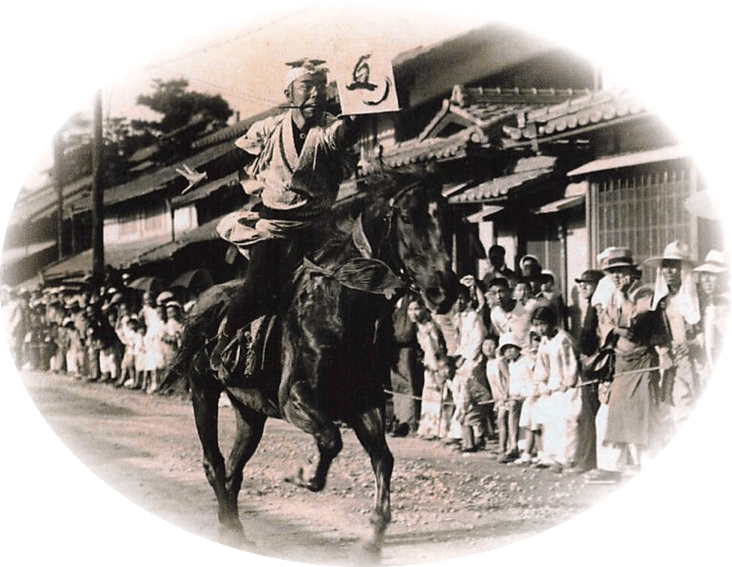
伏見・深草の地で麺を作り続けて120年の老舗製麺所―清水製麺所 伏見区深草の町で約100年以上に渡って、住民や学生、伏見稲荷大社を訪れる観光客、時には軍人の胃袋を支え続けている「清水製麺所」。深草・稲荷との関わりや伝統あるお店を経営していく思いなどをうかがってきました。 清水製麺所の歴史 明治20年代頃より創業した「清水製麺所」は、軍隊へうどんを収めるところから商売を始められ、現在6代目、約120年の歴史を持つ老舗の製麺業者さんです。“製麺所”の名の通り、うどんや中華麺などの麺を製造・販売を行っています。大学や老人ホーム、幼稚園、稲荷大社にあるうどん屋などに卸しており、伏見区内から京都市内、小売店を通じて間接的に全国へ麺を提供しているそうです。 お店について 創業当初は、かつて深草の町に存在した旧陸軍へうどんを卸していたそうです。また、アメリカ兵がお店に来ることもあったようで、ニーズに合わせて缶詰を売ったりしていたそう。6代目の奥さんが嫁いでこられた30年前は、お店や食べるものの選択肢が少なく、かなり忙しかったようです。現在も忙しさや客層自体は変わっていないそうですが、時代の変化につれて、お店ごとにこだわりがあったり、食べる人に合わせて商品を微調整したりと、ニーズの変化に対応しているそうです(提供時間を考慮して、病院へ卸すものは固めにしていたり、保育園・老人ホームへ卸すものは柔らかめ、学校へ卸すものは量を増やしたり)。また、新型コロナウイルスが流行するまでは、伏見稲荷大社にあるうどん屋さんへ卸していた為、インバウンド効果でかなり忙しかったそうです。 製麺業以外にも、小学校へ工場見学としてお店を提供しているそうで、お店には小学生が書いた工場見学のまとめ新聞が多くありました。さらに、町内会の寄り合いの場所としても提供しているそうで、地域に開かれた存在であることがわかります。 伏見・深草との関わり 伏見区深草で約120年も営業を続けてきた清水製麺所さん。町とも深い関係があるようで、代々受け継がれている写真や建物を拝見させていただきました。 この写真は、「藤森祭」で披露される「駈馬神事」を執り行う男性ですが、この写真の方は、清水製麺所のご主人の3代前のひいおじいさんだそうです。お話を伺うと、3代目まで駈馬神事に参加されていたそうで、駈馬の技の1つ「一字書き」で書かれた書が飾られていました。また、京都で古くからある、かまどの上に伏見人形の布袋像を置くという火防布袋の風習も残っていました。 さらに、学生アルバイトも多く雇っており、栄養バランスを考慮した賄いを出しているそうです。アルバイトを辞める学生が、代わりに後輩を紹介するという学生の町・京都ならではのエピソードもお話してくださいました。 お店を営む建物も歴史があり、伝統的な京町家です。町家の引き戸は外からも見ることが出来ます。町家の内部を見てみたい方は、清水製麺所さんから北にまっすぐ進んだところにある龍谷大学町家キャンパスをぜひ覗いてみてください。 最後に 伏見・深草の町で長年に渡って営業されている清水製麺所さん。卸をメインとされていますが、店頭で麺やソースなどの販売もされており、地元住民の方を中心に人気を呼んでいます。京阪本線墨染駅から徒歩6分、本町通に面しています。近隣には藤森神社や琵琶湖疏水があり、まちあるきにはピッタリの場所です。是非訪れてみてください。

伏見街道を行く①~豊臣秀吉も訪れた老舗食事処「祢ざめ家」~ 伏見稲荷大社の稲荷新道と伏見街道(本町通り)の十字路の南西角に歴史ある雰囲気を感じられる祢ざめ家がたたずんでいます。秀吉にもゆかりのある老舗祢ざめ家に訪ねてみました。 豊臣秀吉が店の屋号を付けた! 祢ざめ家の屋号をつけたのは、豊臣秀吉と伝えられています。秀吉が母親の健康を祈願するため、朝早く伏見稲荷大社を訪れました。その時、休憩しようとした秀吉でしたが、早朝であるためどのお店も開いていませんでした。しかし、このお店だけは開いていました。ここでお茶を飲んだ秀吉はとても喜んだそうです。そこで秀吉は店に「ねざめや」の屋号をつけ、しかも「ね」の文字には妻の「祢々(ねね)」の「祢」を与えました。 祢ざめ家の歴史 西暦1540年創業の伝統のあるお店です。今のお店は、昭和初期に建てられた和風建築で、昔ながらの雰囲気を味わえます。メニューには名物のうなぎ丼、いなり寿司、ウズラ焼きなどがあります。ウズラ焼きは、お米などを食べるウズラやスズメを退治するためにこの地域では食べられるようになったと伝わります。 また、店主に今後の意気込みなどをインタビューしたところ、「稲荷大社があってこそ、やっていけている。お越しになったお客様に感謝の気持ちをもって、丁寧に接客していきたい」と答えてくださいました。祢ざめ家さんはご当主で15代目になるそうです。これだけの長い間、営業を続けられる秘訣は、この感謝の心かもしれません。 建物は木造で歴史のある雰囲気を体験できます。店内には伏見人形がおいてあり、伏見の特色を感じとれました。お店の名物であるいなり寿司をいただきました。少し甘味を感じる優しい味わいで、酢飯の中に麻の実と黒ゴマがはいっており、カリッとした食感が楽しめました。訪れた際は是非、名物のいなり寿司を食べてみてください。もう1つの名物、スズメも食べられます。祢ざめ家ホームページ祢ざめ家 NEZAMEYA: 京都・伏見稲荷前 お食事・ご休憩

伏見稲荷大社と生活文化 伏見稲荷大社は京都を代表する社の一つで、全国に約3万を越える稲荷神社の総本山です。歴史が古く、伝統や言い伝えが多く伝わっています。 祀られている神様は倉稲魂神(うかのみたまのかみ)であり、穀物の神様です。そして、その眷属(神の使い)が狐ということになっています。春に山から田へ神が訪れ、秋にはまた里から山へ神が帰っていくという田の神の信仰があり、狐が山から里へ、また里から山へ帰るという状況が田の神の前触れとして、狐に具現化するようになり、稲荷の眷属は狐であるという信仰がしだいに発展していくようになったという一説があります。 稲をつみあげて富裕だった秦伊呂具(はたのいろぐ)という者が餅を的にし、矢を放つ遊びをしていたところ、餅が白鳥になって飛び去り、その鳥の降り立ったところに稲が成ったため、いなりと名付けられました。先祖の行いを後悔し、代々、稲荷山の神木を家に植えて祈り祭ったといわれます。 伏見稲荷大社には様々な神事が行われています。その中でも重要な神事として初午大祭、火焚祭、御神楽があげられます。 重要な神事 ◯初午大祭 倉稲魂神が馬に乗って降臨され、伏見稲荷大社が創建された711年2月の初午の日を祝うお祭です。2日前の辰の日に稲荷山の杉と椎の枝で作られた青山飾りが本殿と摂末社に飾られ、この日を迎える習わしがあります。 <初午の日に行う風習> ・きつね面 初午大祭のときに食べる小豆の粉と白砂糖を使った干菓子です。 ・火難除けの布袋尊 参道などで売られている布袋尊の伏見人形は「火防布袋」といわれ、布袋尊の背中に「火」という字を書き、おくどさん(かまど)の神棚に火難防止として並べられます。 ・しるしの杉 商売繁盛・家内安全の御符(しるし)として、参拝者に授与されています。この風習は平安時代の中頃から始まり、伏見稲荷大社の杉の小枝(しるしの杉)を頂いて、身に着けられていました。 ・畑菜の辛し和え 畑菜は京都の伝統野菜で秦家菜とも表記するそうで、前述した伏見稲荷大社を創建した秦伊呂具から名付けられているそうです。眷属の狐の好物の辛子と油揚げを一緒に頂くと縁起がいいとされています。 ◯火焚祭 11月、秋の収穫の後に豊穣の恩恵に感謝し、神を山に送る祭典です。全国から寄せられた数十万本の願いが書かれた火焚串が神職をはじめ参列者一同で大祓詞(けがれを祓うための祝詞)を唱えて罪障消滅、万福招来を祈ります。 ◯御神楽 御神楽というのは神をまつるために奏する舞楽であり、宮中の神事芸能です。火焚祭の18時から、祭場で焚かれたかがり火の薄明りの中で行われます。神楽歌が歌われ、和琴・神楽笛・篳篥(ひちりき)で奏でられる中、人長舞(じんちょうまい)が舞われます。参考文献・『伏見の歴史と文化』 編者:聖母女学院短期大学伏見学研研究会 発行所:清文堂出版株式会社 発行日:2003年4月30日・『京の社』 著者:上田正昭・岡田精司・五来重・山上伊豆母・井上満郎・松前健・戸田芳実・三浦圭一・景山春樹・安丸良夫 発行所;人文書院 発行日:1985年12月15日・『京都古社寺詳説』 著者:出雲路敬和 発行所:株式会社有吉書店 発行日:1974年12月20日・伏見稲荷大社-http://inari.jp/rite/?month=4%E6%9C%88#334 最終閲覧日:2021年2月20日・京都通百科事典‐https://www.kyototuu.jp/Life/RyouriHatakenaKarashi.html 最終閲覧日:2021年2月20日

The pride and passion of Tanka, the sole remaining Fushimi-ningyō workshop The pottery dolls and figurines known as Fushimi-ningyō are the oldest example of this traditional art, which reached its peak in the late Edo Period. Over ninety separate Japanese varieties of pottery figures have been identified, and it is said that every single one of them draws its roots from Fushimi-ningyō. In its heyday the Fushimi area was home to around 60 pottery kilns, but today there remains but one. This report is an account of a visit to this kiln and store, named Tanka, and an interview with its current master. History of the kiln Tanka was established around the year 1750, and first traded under the name Tamba-ya. Later, in the Meiji Period, the kiln decided to incorporate the master’s name, and so it changed its trading name to Tanka – combining the tan (tam) from the original name Tamba-ya and ka from the name of the kilnmaster of the day, fourth-generation Kasuke. The clay used in the kiln’s pottery works was originally sourced from nearby Mt. Inari. However, after the Pacific War, some issues of property forced Tanka to look elsewhere, and the workshop now sources its materials from Shigaraki in neighboring Shiga Prefecture. The creative process The process of creating a work of Fushimi-ningyō can be divided basically into two stages. April through August is the season for shaping, firing and drying the pieces. September through March is when the artisans finish the figures with paint and enamel. The reason for this is purely seasonal- the clay sets and dries better in drier temperatures. One can see the skill of the artisans in the efficiency with which a piece goes through the various processes over this period of one year. This is why figures that sold out will not be in stock again for another two years, and so it’s always best to buy an item as soon as your heart is set on it. The forms of Fushimi-ningyō The molds used to form Fushimi-ningyō are made of either clay or plaster, and the Tanka kiln has a remarkable collection of over 2000 different shapes. What is just as astounding is that all of these molds are perfectly arranged and ordered on the walls of the workshop. Plaster molds deteriorate over time, but if carefully used, clay molds can last almost indefinitely. Since no new molds are made nowadays, Tanka’s collection is an antique in itself, with every piece dating from the Edo Period over a century ago. This means that no new designs will ever be unveiled, and it is another expression of the artisan’s steely commitment to tradition. The artisan’s philosophy The work ethic of the artisan, creating beautiful items within a defined, repetitive process, is especially intriguing. Asked about his attitude to his work, Tanka’s master replies that the key lies in routine. But it is within the ultimate routine- machine-like production- where true artisans blossom. If an average person were to paint the same figure in the same way, day in day out, surely they would tire of it. The master adds, “Once, as a diversion, I tried using a different color palette on a piece, but it just didn’t feel right. The comment from customers that motivates me most of all is ‘The pieces never change.’ ” Process as automatic routine. It’s something artisans have in common with top sportspeople such as baseball star Ichiro, and something that gives one a renewed sense of admiration for them. Another interesting analogy from the master is how he likens the relationship between artisan and consumer to a spider’s web. Rather than a single thick strand, the web is made up of hundreds of delicate thin ones. That is, a great number of connections, even if they are weak, are preferable to a single, close relationship. Again we see the professionalism of the artisan; he is here to maintain a business rather than simply extend his social circle. Nowadays the figures are sold online, and at certain temples and shrines, but wouldn’t it make better business sense to sell them through outlets such as department stores? In fact there was a time when Tanka did sell their wares through a department store, but this this relationship soured due to the store’s less-than- consummate attitude, and the workshop broke off the agreement. The future of Fushimi-ningyō Finally, we ask for the master’s thoughts on the future of the brand. Unsurprisingly, his goal is to continue making the same items to the same standards, to protect and carry on the name. But he says that this is getting more and more difficult, as the products that sustain the craft- the brushes and the paints, gradually disappear from production. Though it’s clear that running again the tide of the times will not be easy, it’s just as clear that the work is vital and should be protected in its traditional forms. The passion of Tanka and its (in a good sense) quirky, exacting kilnmaster is unmistakable. I hope that though this piece the reader has gained some insight into the history and pride behind Fushimi-ningyō, the and the interest to learn more about the precious artform. Bibliography:Website - http://www.tanka.co.jp/base.htm

Joseon missions to Japan : Toyotomi Hideyoshi’s cultural legacy in Fushimi Kyoto’s Fushimi Inari Shrine is by far the most popular tourist attraction in the city, bringing in countless visitors from all over the globe. The street leading to the temple complex, Fushimi Kaidō, is thronged with people most days of the year. Over four centuries ago, the street was just as full of visitors, but this was because of an incident regarding the local area’s pottery figures, Fushimi-ningyō. In this paper I would like to look closer at this event and its influence on the city of Kyoto. Fushimi Kaidō and the Joseon Missions From the early stages of the Edo bakufu era until the end of the 18th century, the Joseon nation sent a total of 500 envoys on 11 diplomatic missions (each time a new shōgun was named) to Edo, the Japanese capital. These envoys were said to usually arrive in Yodo on a gosabune samurai warship, and head for Tō-ji in Kyoto via the town of Toba. However, records show that there were two occasions on which the envoy group passed along the Fushimi-Kaidō.The first instance was in 1617, when an envoy visited in celebration of the Osaka Normalisation Treaty, and to repatriate Japanese prisoners taken on the occasion of Hideyoshi’s invasions of Joseon. When moving the enjoy from Fushimi Castle to a special banquet hall the Edo Shogunate had prepared at Nara’s Daibutsuden, the party travelled along the Fushimi-Kaidō.The second occasion was in 1624, when the party used Fushimi-Kaidō as a return route to Yodo from Edo. This trip was immortalized in artworks at the time, so even now we have a good idea of what the procession might have looked like. In one famous example, the Rakuchū Rakugai-zu, no less than 13 of the work’s total 100 scenes depict townspeople watching the envoy procession. Given that they are depicted in major artworks these envoy visits were obviously influential events in the lives of Fushimi and Kyoto locals. Perhaps they watched the parades of visiting dignitaries with the same sense that contemporary Japanese watch parades of exotic theme parks. Let’s take a closer look at what the Fushimi Kaidō was like at the time. Fushimi Kaidō circa 1617 What was the Fushimi Kaidō like at the time of the first Joseon Mission? We may get some hints from surviving documents, such as the illustrations Engelbert Kaempfer, head of the Dutch Nagasaki Trading Post, or Fusoroku, Joseon Mission administrator Lee Kwon-jik’s written account of the missions. Through these we witness that the stretch of road between Fushimi and Kyoto was lined with homes and eateries, while in the Eastern Mountains, temples and pagodas stood majestically, surrounded by yet more teahouse and taverns. With such a proliferation of places to eat and drink, one can readily imagine how routinely lively the Fushimi Kaidō must have been. Fushimi Kaidō circa 1624 The second time the Joseon Mission parade passed along the Fushimi Kaidō, the area was described by Kang Hong-Jeung in his account of the visit Tōsaroku. After Toyotomi Hideyoshi’s death, the castle and surrounding living quarters of the daimyo fell into disrepair, and the only remaining features of the town were a few local temples. It’s clear from this account of the visit that the Fushimi Kaidō was vastly different to the one passed through by the Joseon Mission just seven years earlier. Even this writer, who passes through Fushimi every day, finds it difficult to imagine the area in such a run-down state, and just as surprising that the catalyst for such a dramatic change was the death of Hideyoshi. It’s obvious that he was a irreplaceable figure in the history of the region. Joseon Missions and Fushimi-ningyō The processions that passed along the Fushimi Kaidō in those days, be them from the Joseon Missions or other leaders such as that of the Tsushima-Fuchū Domain, each featured close to 3000 members. The influence of the Joseon Missions on Japanese culture was immense, especially in the festivals observed in Edo and Nagoya, as well as crafts such as clay figurines. For example, it’s said that a part of the San’nō Festival of Edo contained a recreation of the Joseon Mission Parades. Furthermore, the Joseon Missions also influenced the local craft of Fushimi-ningyō. For example, according to the head of the Fushimi-ningyō store Tanka, the figure known as a zō-nori karako was inspired by the elephants that were part of the grand Joseon Mission procession. As the missions made their way around Japan, the impact they left of the local populace was considerable, and it’s possible that the nation was gripped by what is known in modern parlance as a “Korean Boom.” It’s also not unthinkable that the artisans creating Fushimi-ningyō were moved by the sight of the processions, and that this roused their creative spirits. The excitement and emotion of the times is passed on to us today through Fushimi-ningyō figures such as zō-nori karako and the Joseon Mission envoy figure. Joseon Mission envoy figures As stated above, it’s clear that as the Joseon Missions passed along the Fushimi Kaidō, they had a deep influence on the crafts of the region. The Korean envoy motif has been used in many regional varieties of pottery figures all over Japan, but among these the Fushimi-ningyō examples have been singled out for their elegant colors and designs. The envoy figures feature a decorative headress, and wear the male overcoat known as a durumagi and shoes. At the time, footwear was not a custom among the common Japanese, so the fact that the figures wear them is proof of their Korean inspiration. The artisans who created these figures obviously took careful note of the sartorial differences between Japanese and Koreans at the time. The superiority of the Fushimi-ningyō Joseon Mission figures to all other examples in Japan is yet more proof of the pride that the Fushimi artisans took in their work. Zō-nori karako 「The Zō-nori karako (elephant-riding boy) figure is, as its name suggests, a piece that features a small boy in Chinese clothing sitting on the back of an elephant. It’s one of the most representative of all the Fushimi-ningyō figures. It’s believed that artisans were inspired to create these by the sight of elephants paraded through Kyoto after Hideyoshi’s invasions of the Korean Peninsula. In fact, a bull elephant was led through through Kyoto on April 26th, 1729, being sent from Nagasaki to Edo. Roads were closed and the townspeople were forbidden to leave their homes as the elephant passed, and another reason for its visit to Kyoto, aside from resting the creature, was so that the Emperor might have an opportunity to inspect the animal. The Emperor and nobles wrote songs in commemoration of the beast’s visit to the capital, and observed it as it ate. The elephant left Kyoto at around 10am on May 10th, and continued on its way to Edo, leaving countless admirers in its wake. It’s incredible to think of what Kyotoites thought of this strange animal, in an age of no smartphones, television, or internet. Perhaps some of them expressed their surprise and interest through the words of poetry and song. However, Fushimi artisans were able to express this through their craftwork, in an attempt to immortalise the feelings of surprise and joy that locals must have felt at the time. Bibliography:・Nakao Hiroshi, 2011, Chōsen Tsūshinshi no Ashiato- Nikkei Kankeishi-ron, Akashi Shoten Publishing・Shin Gi-su, 2002, Shinpan Chōsen Tsūshinshi Ōrai - Edo Jidai kara 260-nen no Heiwa to Yūkō, Akashi Shoten Publishing ・Murayama, Shin’ichi, 2003 Kyoto Daibutsu Goten Seisui-shi.

Fushimi dolls-Born in Kyoto! A look at the essence of the first clay dolls- Early history 「What do you think of when you hear the words “Fushimi dolls”? Fushimi dolls are a traditional craft product of Kyoto, born in Kyoto some 400 years ago. Not only do the dolls themselves have a long history, their origins can be traced back far beyond the Edo period (1603-1868) to the Nara period (710-794). I will look at the circumstances before and after the genesis of Fushimi dolls. The origins of Fushimi dolls Fushimi dolls are said to have originated from earthenware and clay figurine artisans who lived in the Fukakusa area during the Nara period and were employed by the Imperial court to make its earthenware. It is thought that as time went on the artisans began to set up their own businesses producing everyday earthenware. According to Kōgei Shiryō (Sources on Crafts) written in 1877 by Kurokawa Mayori and published by the Museum Bureau, the unit in charge of museum administration in the Ministry of Education and Ministry of Agriculture and Commerce at the time, the first person to make earthen figure dolls as children’s toys was a person by the name of Ikaruga ō of Fushimi in 1615. The method used by Ikaruga Kōemon to make his dolls was to first fire clay in a pair of front and back molds in a kiln, attach the two fired parts together with gelatin, and then finally paint the doll. This is, apparently, the method Fukakusa craftsmen also used, and is very similar to the method used to make Fushimi dolls today. Perhaps this is why Ikaruga Kōemon’s earthen figures were said to be masterpieces of a rarely seen caliber, and why 1615, which was the first year of the Genna years (1615-1624), was deemed the year of origin of Fushimi dolls and Ikaruga Kōemon their founding father? A key to the birth of Fushimi dolls Fushimi-shi (Fushimi Journal) published by Fushimi Town Office, Kii County, Kyoto Prefecture, on June 20, 1915 references a “Tokugawa era companion log”. The log is a table tracing the history of merchant colleagues in Fushimi at the time. At the end of the table is the sentence “Fushimi doll colleagues, silver payment from Genna years”, indicating that a Fushimi doll union paid silver to the town office in the Genna years. This is proof that doll production or retailers already existed to a significant degree. Furthermore, the fact that Ikaruga Kōemon had “colleagues” when he began to make Fushimi dolls, as noted in the Japanese craft sourcebook Kōgei Shiryō, is a crucial key in the story of Fushimi dolls existing prior to 1615. In other words, it would appear that Ikaruga Kōemon was not in fact the founder of Fushimi dolls despite being deemed so. The mystery deepens. Furthermore, Fushimi-shi notes changes in Fushimi dolls from the Nara period through to the Genna years in the Tokugawa period (1603-1868), mentioning that that Ikaruga Kōemon’s works commanded high prices and that Fushimi dolls were affected by a shift from water transportation on the Yodo River to railway and other forms of land transportation. This shift in transportation effected a decline in Fushimi dolls for a period of time before they were to be seen on the road to Fushimi Inari Shrine, albeit in small numbers, thanks to the Inari faith. So far, I’ve written about circumstances before the birth of Fushimi dolls and we encountered the person Ikaruga Kōemon. Considering that his doll-making method is similar to that used to make Fushimi dolls and that Fukakusa craftsmen made their dolls using methods the same as his, I was completely under the impression that Ikaruga Kōemon was indeed the founding father of Fushimi dolls. However, I found out that Fushimi dolls already existed when Ikaruga Kōemon began making dolls. So, who started making them and when? There’s still a lot we don’t know. The deeper one investigates Fushimi dolls, the more interesting they become. Next, I wish to look at what happened after Fushimi dolls were born and delve further into the appeal of Fushimi dolls. ※TriviaWhen it comes to pottery in Kyoto, it’s Kiyomizu-yaki that everyone knows. But believe it or not, a type of pottery called Fukakusa-yaki has existed since the Heian period (1068-1185), the Fujiwara era, before Kiyomizu-yaki was even born. In other words, Fukakusa is the birthplace of a pottery with a longer history than the more famous Kiyomizu-yaki. Overview Characteristics of Fushimi dolls Fushimi dolls were sold as souvenirs at Fushimi Inari Shrine in the early Edo period (1603-1868), and are said to be the archetype of all folk toys and clay dolls. Folk toys modeled on Fushimi dolls spread across Japan. Fushimi dolls are not charms but figurines of ancient believers. As there are different types of dolls made in various sizes, one can find a doll that suits one’s own taste. Kabuki-related varieties are painted in set color schemes, but some of the other dolls are painted in color combinations unthinkable today. One of the charms of Fushimi dolls is that one can feel the sensibilities of bygone eras. In the past the dolls were made from soil from Mt. Inari, but due to ownership issues, presently soil from Shigaraki in Shiga Prefecture is used. Since the material and paint used for Fushimi dolls has varied over the ages, slight variations can be seen even in dolls of identical type. I believe the main feature and greatest charm of Fushimi dolls is that each one has a slightly different expression and no two are exactly alike. One of the true pleasures of Fushimi dolls is that one can select the doll that suits oneself from among the many available. History of Fushimi dolls Fushimi dolls had a close association with the kabuki of the time. Artisans made dolls modeled on kabuki actors which they sold to the public. Fushimi dolls of a popular actor of the day, Ichikawa Ebizō, were apparently hugely popular with kabuki fans. One can imagine queues of people lining up in front of doll shops to buy dolls just like the queues in front of the tapioca shops that are fashionable at the moment. I personally am sensitive to trends and popular things, so I think I too would be buying kabuki-related Fushimi dolls had I been alive then. Back to the topic, we’ve seen how Fushimi dolls took the world by storm thanks to kabuki. As time went on, however, fewer people were making Fushimi dolls, and the dolls all but dwindled out. However, people began to buy Fushimi dolls once again due to the Inari faith and people’s wishes for resolution of political unrest and successive famines, and the dolls spread throughout Japan on passenger ships. The result was that, while not to the extent of former days, Fushimi dolls did begin to appear once again at the gates of Fushimi Inari Shrine and around the country. After once being a hit but then falling into decline as a result of fewer artisans making them, there was once again increased demand for Fushimi dolls against a backdrop of political unrest and successive famines. Famine and political unrest inflict loss and harm onto people and shouldn’t happen. However, if they had not happened, Fushimi dolls may not have made a reappearance in the world. As I see it, it was thanks to famine, political unrest and the Inari faith that Fushimi dolls have survived to the present day. For that reason, from the point of view of the survival of Fushimi dolls, I can’t help feeling gratitude for the famine, political unrest and Inari faith of the day. Thoughts of a Fushimi doll preservationist and seller To find out more about Fushimi dolls, I visited Hirata folk toys, a store near Toji Temple that sells folk toys from all over Japan. The owner spoke to me about her feelings about Fushimi dolls, their history, and preservation activities. Although Fushimi dolls exist to this day, they do not apparently exist in large numbers. The sole Fushimi doll maker today, Tanka, which I touch on below, has about 2,000 Fushimi doll molds. This is not the entire number that existed as some have been broken and lost.1) In view of the situation, a preservation society has been established to preserve remaining Fushimi dolls and hand them down to future generations. The preservation society is active in making dolls using the existing Fushimi dolls molds and preserving the dolls. This speaks to just how long a history Fushimi dolls have so far and the value in continuing to preserve them, doesn’t it? Artisans make each individual Fushimi doll by hand, putting their all into each doll and breathing life into them. That’s why each one has its own special flavor. My impression is that the reason each Fushimi doll has its own individual flavor and expression is that artisans focus not on producing large quantities of dolls but rather on creating dolls of high quality. The owner of Hirata folk toys speaks passionately, “No two Fushimi dolls are the same. Different paints have been used over the ages, and therefore dolls of different eras have a different feel. The greatest appeal of Fushimi dolls is how even dolls from the same mold have a different flavor depending on the era. I hope people will keep this in mind and use it to find a doll that appeals to them, so they feel attached to it.” 1)In the past some 60 workshops making Fushimi dolls existed along the Fushimi-kaido Road. However, to this day all of these potters but Tanka have disappeared due to factors such as the Pacific War. Consequently, only one store, Tanka, remains today, and that is the only place Fushimi dolls are made. In addition, as fewer shops are stocking Fushimi dolls, they are becoming harder to acquire. They have become such a rarity that if you miss out on buying one when you want one, you may never have the opportunity. Fushimi doll buyers and Fushimi dolls not for sale Next, I asked about the buyers of Fushimi dolls, and a doll on which a “Not for sale” sign was displayed. Fushimi dolls are bought by grandfathers, grandmothers, parents, etc. The sweet bun eater is a popular choice for those who wish their grandchild or child to be clever. Animals such as ogres and cats are popular with foreign tourists, and some people even buy them as the basis for a design for a tattoo or a picture. That tells us that Fushimi dolls are popular both inside and outside Japan, and there are still many people who wish to purchase one. The owner told me that the Fushimi doll not for sale is from the Edo period and the only one of its kind still existing. It is to be preserved and therefore cannot be sold. She also said that it would not be able to be sold even if there was more than one of the doll since its rarity and lack of comparable market price make it impossible to determine a selling price. Now that I’ve described Fushimi dolls, I’ll introduce several common types. -Sweet bun eaterThe figure of a child holding a sweet bun in its hand. It is said that when asked “Who do you like better, your mother or your father?”, the child broke the sweet bun he was holding in his hand in two and answered, “Which piece of this bun is sweeter?” This made him a popular symbol of clever children. Many people buy this doll in the hope their child will be clever. It is also given as a present to wish for safe childbirth or as baby-birth gift. -FoxSeen as a messenger of god, there are several versions of the fox which often come in symmetrical pairs that are displayed on Inari home altars. The fox comes in many forms including as a divine fox, riding a horse, holding a money chest, or holding a ritual wand. The fox motif is said to be unique to Fushimi dolls. -DenboOne of the first types of Fushimi dolls to have been made. Three stacked unglazed pottery plates- small, medium, and large- each painted in a different color such as red, green and ultramarine blue around the edge. Small rice crackers, roasted beans, seeds or the like were placed on the plates and offered to Buddhist or Shinto deities. Denbo are a legacy of Fushimi dolls’ origins in earthenware making. -Hotei figureThe figure of Hotei is referred to as “Fire-preventing Hotei”. With the Chinese character for “fire” written on his back, Hotei believed to prevent fires if he is displayed on the home altar. In Kyoto it is customary for homeowners to buy a small Hotei figure on the first day of February each year to display on the home altar. It is said that if one starts with the smallest figure and subsequently collects a total of seven Hotei figures the home will be blessed with good fortune. However, if misfortune occurs while the seven are still being acquired, the acquired figures must be thrown in the river and the collection process begun again. Notably, the Hotei figure was a favorite of Ito Jakuchu, a painter who made a living painting pictures of Fushimi dolls. 2. Fushimi dolls? Fukakasa dolls? Inari dolls? Which is the correct name? Origin of the name Fushimi dolls Known as one of Kyoto’s traditional crafts and older than the famous Kiyomizu-yaki, Fushimi dolls were apparently not always known by this name. Then why are they called “Fushimi dolls” now? Despite this being the name commonly used to refer to these figures today, we are apparently yet to find an explanation that shows for certain why this is. There are, however, several theories. Let’s take a look at them in detail. What they were called before becoming “Fushimi dolls” In the past, Fushimi dolls were referred to variously as “Fukakusa-work” and “Inari dolls”, names that are related to the places where the dolls were made. Dolls made in Fukakusa where our Ryukoku University is located were called Fukakusa-work after the place name Fukakusa. On the other hand, it is thought that “Inari dolls” became a general name for figures that were made from clay from Mt. Inari, denoting earthenware foxes and things that had some kind of direct relationship with Inari Shrine, such as Hotei or earthenware bells. However, by the end of the Tokugawa shogunate era (1853-1867), “Fushimi dolls” was being used, with “Fukakusa dolls” having already fallen out of favor by the Kasei era (1804-1830). As someone who commutes to Fukakusa on a daily basis, I am saddened that the name Fukakusa has disappeared. There must, however, be a reason for the disappearance of the name Fukakusa. Next, I want to look into why “Fukakusa dolls” stopped being used and “Fushimi dolls” began to be used. Theories as to why the name “Fushimi dolls” came to be used. No. 1. In the past, the dolls we have been talking about were sold at the gates of Fushimi Inari Shrine and bought by many people as a souvenir of their visit to the shrine. It is said that the dolls came to be referred to as “Fushimi dolls” in reference to their being bought at Fushimi Inari Shrine or being bought as a souvenir on the first day of February, which is associated with Fushimi, thus replacing the name “Fukakusa dolls”. Hearing this theory, it occurred to me that place names greatly affected the naming of the dolls. While we can’t know the truth without asking people of that time, I speculate that it was not the name of the place where the dolls that were made but the name of the place where the dolls were bought by which they became known. Theories as to why the name “Fushimi dolls” came to be used. No. 2. As discussed, “Fushimi dolls” took over from “Fukakusa dolls” and “Inari dolls” as the common name. However, the term “Fushimi dolls” was not used in the local area where names such as “clay dolls”, “clayware dolls” and “denbo” conveyed the intended meaning sufficiently. As such, there is a theory that they were called by the name “Fushimi dolls” with other regions in mind. Fushimi dolls circulated throughout the country on boats from the port of Fushimi. As the dolls spread throughout the country, the name “Fushimi dolls” became synonymous with these figures and used to refer to clay dolls in general. As someone from Kyoto, it makes me happy and even proud that a traditional craft product of Kyoto spread throughout the country and became synonymous with clay dolls. I’ve gone off on a tangent. Let’s go back to our earlier discussion. Behind the spread of Fushimi dolls throughout the country were factors including the Inari faith that captivated the hearts of a population shivering in the face of political unrest and successive famines, the head temple that was Fushimi Inari Temple, an abundance of high-quality clay, and clay-work tradition and techniques. There was also the remarkable talent of the merchants of Fushimi who cleverly pulled all these factors together to spark a golden age of Fushimi dolls. The name “Fushimi dolls” is more than simply a name reflecting a production area, but a name that became firmly rooted in society under the strong influence of the merchants of Fushimi and the Inari faith. Conclusion Writing about the origins of the name “Fushimi dolls”, I discovered that there were actually various names for them before the name “Fushimi dolls” that is so normal to us now, and that the process of change was deeply connected with politics and religion of the time. Furthermore, although I haven’t expounded on it here, I discovered that there are many historical secrets in Fukakusa and Fushimi, like the fact that Fukakusa boasts a type of pottery older than Kiyomizu-yaki and that the artist Ito Chujaku had a connection with Fushimi dolls. I never imagined that this Fukakusa area that I associate with without much thought is so rich in history and associations with famous people. I feel proud that I study at a campus in Fukakusa. The deeper one delves into one’s subject of research, the more fascinating it becomes. If you have something that you’re even a little interested in, how about trying to do some research? You might discover something new just as I did with Fushimi dolls. References:・Tanka The origins of Fushimi dolls - http://www.tanka.co.jp/base.htmLast retrieved August 9, 2019・Hirata Folk Toys Fushimi dolls - https://www.kyodogangu-hirata.com/fushimiLast retrieved August 9, 2019・Folk toys Fushimi dolls Fushimi dolls - http://kyoudogangu.xii.jp/fushimi.htmLast retrieved August 9, 2019・Fushimi dolls - Author: SHIOMI, Seiran Publisher: Kawara Shoten Date of publication: July 10, 1967